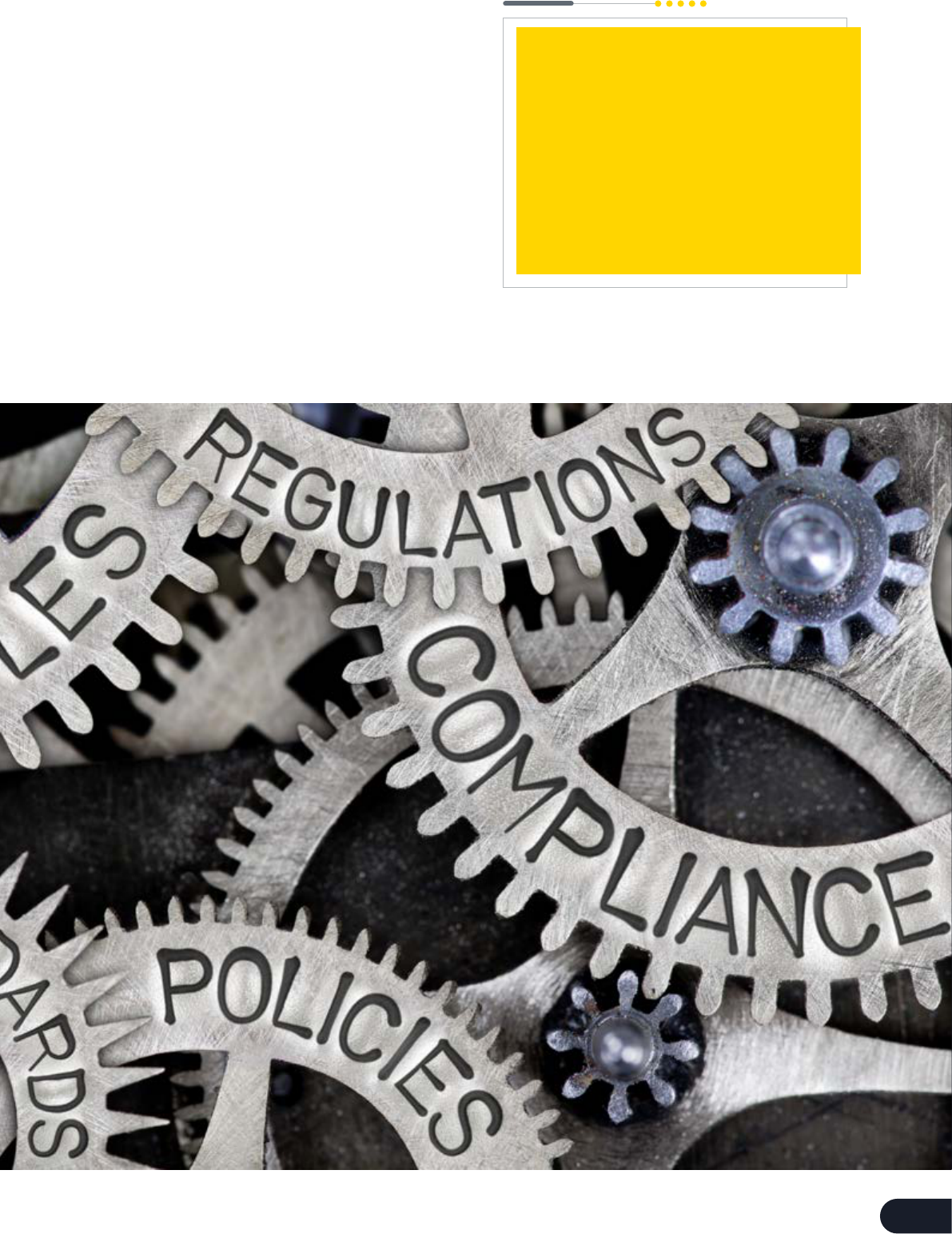
Year-end
considerations
Financial services sector
supplement
May 2023

The year 2022 was full of disruptive factors such as high ination, Ukraine and Russia war, interest rate
volatility, events in crypto market etc., due to which there has been a major impact on the BFSI (Banking,
Financial services, and Insurance) sector. The year 2023 has kickstarted with a few major events, such as
failure of few global nancial institutions, which has increased the fear of global nancial crises. In light
of these events, governments, and central banks all over the world have become more vigilant, especially
in the areas of governance and controls.
There have been various regulatory developments/amendments during the year to ensure that entities in
the nancial service sector are operating efciently. The idea is to adopt high standards of governance in
a globally competitive manner. There are several amendments around new accounting framework such
as expected credit loss, scale-based regulation for NBFCs, IFRS 17 for Insurance companies, Ind AS for
mutual funds etc.
It is our constant endeavor to help entities stay updated with latest developments and changes in nance
function. As all entities gear-up to nalize their nancial statements for the year-ended 31 March 2023,
it is critical that they evaluate all key changes in accounting and regulatory space which impacts nancial
and corporate reporting. This publication provides critical updates and insights to help nance leaders
and teams update themselves with the changes applicable for the year-end closure and ensure that the
companies are well prepared for the closure with the changes.
Purpose of this publication
This publication is the nancial services sector supplement of our year-end reporting considerations
publication which provides an overview of the changes in accounting standards and interpretations as
well as regulatory changes up to 31 January 2023 which are relevant for nancial year (FY) 2022-
23 and beyond. It covers key changes which are relevant to the BFSI sector and provides a glance at
the regulatory and other changes that have been issued during this year, which have consequential
impact on accounting, disclosures, and compliance with regulations. It does not attempt to cover all the
regulatory pronouncements but covers the key changes impacting the nancial year-ended 31 March
2023. This publication does not aim to provide an in-depth analysis or discussion on the changes,
rather it aims to highlight the key aspects of these changes. Reference should be made to the text of the
pronouncements before taking any decisions or actions.
The publication is divided into the following sections:
Section 1: Banks and NBFCs
Section 2: Insurance
Section 3: Wealth and Asset Management
Hope you all nd the publication useful.
Foreword
Adarsh Ranka
Financial Accounting Advisory Services Leader,
Partner with an Indian member rm of EY Global

Table of
contents
Section 1: Banks and NBFCs
Section 2: Insurance
Section 3: Wealth and Asset Management
A. Impacting nancial statements
B. Other Regulatory changes
1. Reserve Bank of India (Financial Statements - Presentation and Disclosures) Directions, 2021
2. Reserve Bank of India (Unhedged Foreign Currency Exposure) (UFCE) Directions, 2022
3. Establishment of Digital Banking Units (DBUs)
4. Regulatory Restrictions on Loans and Advances
5. Disclosures in Financial Statements- notes to accounts of NBFCs
6. Provisioning requirement for investment in Security Receipts (SRs)
1. Discussion Paper (DP) on Expected credit loss Framework for Provisioning by Banks
2. Requirement of compliance function and role of Chief Compliance Ofcer (CCO)
3. Guidelines on Compensation of Key Managerial Personnel (KMP) and Senior Management in
NBFCs
4. Updates on scale-based regulations
5. Guidelines on digital lending
6. Discussion Paper (DP) on Securitisation of Stressed Assets Framework (SSAF) –
applicable to all Banks and NBFCs
7. Review of regulatory framework for Asset Reconstruction Companies (ARCs)
8. Some of the key master directions which are updated by the RBI during the FY 2022-23

Section 1
Banks and NBFCs
Impacting
nancial statements
1. Reserve Bank of India (Financial Statements - Presentation and
Disclosures) Directions, 2021
2. Reserve Bank of India (Unhedged Foreign Currency Exposure) (UFCE)
Directions, 2022
3. Establishment of Digital Banking Units (DBUs)
4. Regulatory Restrictions on Loans and Advances
5. Disclosures in Financial Statements- notes to accounts of NBFCs
6. Provisioning requirement for investment in Security Receipts (SRs)
A

5
Financial Services Sector supplement
RBI had issued Master Direction on Financial Statements
- Presentation and Disclosures vide direction dated 30
August 2021. Subsequent to this, Reserve Bank of India
(RBI) has issued some clarication and has updated the
master direction during FY 2022-2023. This master
direction contains the format of Balance Sheet and Prot
and Loss Account, notes and instructions for compilation,
disclosures in notes to accounts and instructions and
format for the consolidated nancial statements. Apart
from nancial statements presentation and disclosures, this
master direction also includes other instructions such as
inter branch account provisioning, reconciliation of nostro
accounts, maintenance of reserve fund and deferred tax
liability on special reserve. Following are the key updates
that were issued by the RBI during the FY 2022-23:
Reporting of reverse repos with Reserve
Bank on the bank’s balance sheet
Disclosure of Divergence in Asset
Classication and Provisioning
1
Reserve Bank of India (Financial Statements - Presentation and
Disclosures) Directions, 2021
In order to bring more clarity on the presentation of reverse
repo on Bank’s balance sheet, RBI issued clarications on
reverse repo transactions dated 19 May 2022. As per
these guidelines, banks are required to report reverse repos
in their balance sheet as follows:
•
All type of reverse repos with the Reserve Bank
including those under Liquidity Adjustment Facility shall
be presented under sub-item (ii) ‘In Other Accounts’ of
item (II) ‘Balances with Reserve Bank of India’ under
Schedule 6 ‘Cash and balances with Reserve Bank of
India’.
•
Reverse repos with banks and other institutions having
original tenors up to and inclusive of 14 days shall be
classied under item (ii) ‘Money at call and short notice’
under Schedule 7 ‘Balances with banks and money at
call and short notice’.
•
Reverse repos with banks and other institutions having
original tenors more than 14 days shall be classied
under Schedule 9 – ‘Advances’ under the following
heads:
•
A. (ii) ‘Cash credits, overdrafts and loans repayable
on demand’
•
B. (i) ‘Secured by tangible assets’
•
C. (I).(iii) Banks (iv) ‘Others’ (as the case may be)
In terms of paragraph C.4(e) of Annexure III to
the Reserve Bank of India (Financial Statements
- Presentation and Disclosures) Directions, 2021,
commercial banks (excluding Regional Rural Banks
(RRBs)) are required to disclose details of divergence
in asset classication and provisioning where such
divergence assessed by the RBI exceeds certain specied
thresholds. In order to strengthen compliance with
income recognition, asset classication and provisioning
norms, RBI has revised the specied thresholds for
commercial banks and introduced similar disclosure
requirements for Primary (Urban) Co-operative Banks
(UCBs).
Accordingly, for the nancial statements for the year
ending 31 March 2023, banks shall make suitable
disclosures in the manner specied in paragraph C.4(e) of
Annex III to the afore-mentioned Directions, if either or
both of the following conditions are satised:
i. the additional provisioning for non-performing assets
(NPAs) assessed by the RBI exceeds 10% of the
reported prot before provisions and contingencies
for the reference period; and
ii. the additional Gross NPAs identied by the RBI exceed
10% of the reported incremental Gross NPAs for the
reference period.
Provided further that in the case of UCBs, the threshold
for reported incremental Gross NPAs specied in
paragraph (ii) above shall be 15%, which shall be reduced
progressively in a phased manner, after review.
The thresholds specied in above shall be revised for
disclosures in annual nancial statements for the year
ending 31 March 2024, and onwards, as under:
*May be reduced subject to review
I
II
How we see it: The main objective of the above
notication is to bring clarity to the presentation
of reverse repo on the Balance sheet. Prior to this
notication, there was a mixed practice followed by
Banks to present balance in Reverse Repo Account
under Schedule 7 (Balance with Banks and Money
at Call & Short Notice) or Schedule 9 (Advances).
Ref. Threshold linked to
Commercial
Banks (%)
UCBs (%)
(i)
Reported prot
before provisions and
contingencies
5 5
(ii)
Reported incremental
Gross NPA
5 15*

6
Financial Services Sector supplement
How we see it: It seems that the RBI’s intention
is to tighten the disclosure norms around the
divergence of NPA assets. Divergence takes
place when the RBI nds that a lender has under-
reported (or not reported at all) bad loans in a
particular year.
Earlier, the commercial banks (excluding RRBs)
were required to disclose details of divergence
in asset classication and provisioning where
such divergence assessed by the RBI exceeds
certain specied thresholds (10% of the reported
prot before provisions and contingencies for
the reference period and additional Gross NPAs
identied by RBI exceeds 15% of the published
incremental Gross NPAs).
Now, RBI mandated similar disclosure requirements
for UCBs also and revised the specied thresholds
for commercial banks.
How we see it: The above notication is aimed
at enhancing transparency in a bank’s nancial
statements through detailed disclosures. The banks
will have to ensure that the necessary data for
the above-mentioned disclosure is appropriately
available and presented in a manner that aids in
better understanding of the nancial position and
performance of the banks.
Disclosure of material items
In terms of Part A of Annexure II to the mentioned
Directions, in case any item under the subhead
“Miscellaneous Income” under the head “Schedule
14-Other Income” exceeds 1% of total income,
particulars shall be given in the notes to accounts.
Similar instructions exist in the case of subhead “Other
expenditure” under the head “Schedule 16-Operating
Expenses” where particulars shall be given in the notes to
accounts for other expenditure exceeding 1% of the total
income.
Payments bank shall disclose particulars of all the items
under the Schedule 14(I)-Other Income-“Commission,
Exchange and Brokerage” that exceeds 1% of the total
income in the notes to accounts.
In order to ensure greater transparency, banks shall also
disclose the particulars of all such items in the notes
to accounts wherever any item under the Schedule
5(IV)-Other Liabilities and Provisions-“Others (including
provisions)” or Schedule 11(VI)-Other Assets-“Others”
exceeds 1% of the total assets. These instructions are
applicable to all commercial banks. These instructions
shall come into effect for disclosures in the notes to the
annual nancial statements for the year ending 31 March
2023 and onwards.
III

7
Financial Services Sector supplement
2
Reserve Bank of India (Unhedged Foreign Currency Exposure) (UFCE)
Directions, 2022
This circular is applicable to all commercial banks
(excluding Payments Banks and RRBs) and the overseas
branches / subsidiaries of banks incorporated in India.
These instructions shall come into force from 01 January
2023.
To address the risk on bank’s books, banks were advised
to maintain incremental provisioning and capital
requirements for their exposures to entities with UFCE.
The process of computing incremental provisioning and
capital requirements can be summarized in the following
steps:
•
Step 1: Assess the foreign currency exposure (FCE) of
the entity.
•
Step 2: Ascertain the amount of UFCE from entities’
FCE, taking into account two types of hedges – natural
hedge and nancial hedge.
•
Step 3: Estimate the potential loss to the entity
from UFCE exposure to entity due to exchange rate
movements.
•
Step 4: Maintain incremental provisioning and capital
requirements against banks’ exposure to the entity
based on the impact of likely / potential loss on
entity’s overall protability.
Computation of Unhedged Foreign Currency Exposure:
a. Banks should ascertain the Foreign Currency Exposure
(FCE) from all sources, including the foreign currency
borrowings and external commercial borrowings of
all entities at least on an annual basis. Banks shall
compute the FCE following the relevant accounting
standard applicable to the entity. Banks shall consider
the items maturing or having cash ows over the
period of next ve years.
b. Banks should assess the UFCE of entities with FCE by
obtaining information on UFCE from the concerned
entity. Information on UFCE shall be obtained from
entities on a quarterly basis based on statutory audit,
internal audit, or self-declaration by the concerned
entity. UFCE information shall be audited and certied
by the statutory auditors of the entity, at least on an
annual basis.
Provisioning and Capital Requirements
a. The largest annual volatility in the USD-INR exchange
rates during the last 10 years should be used to
determine the potential loss to an entity from UFCE.
For other than the US currency UFCE, it should be
converted to US dollar using current market rates for
determining potential loss.
b. Susceptibility of the entity to adverse exchange rate
movements should be determined by computing the
ratio of the potential loss to the entity from UFCE and
the entity’s Earnings Before Interest and Depreciation
(EBID) over the last four quarters as per the latest
quarterly results certied by the statutory auditors.
•
In cases where banks are not in position to obtain
information on UFCE or EBID from listed entities for
the latest quarter due to restrictions on disclosure
of such information prior to nalization of accounts,
banks shall have the option to use data pertaining to
the immediately preceding last four quarters.
•
In case of unlisted entities where the audited results
of the last quarter are not available, the latest audited
quarterly or annual results available shall be used.
The annual EBID gure used shall at least be of the
last nancial year.
c. Banks shall apply incremental capital and provisioning
requirements to all exposures to such entities as under:
Potential loss/
EBID (%)
Incremental
provisioning
requirement
Incremental capital
requirement
Up to 15 % 0 0
More than 15%
and up to 30%
20bps 0
More than 30%
and up to 50%
40bps 0
More than 50%
and up to 75%
60bps 0
More than 75 % 80 bps 25% point increase in
the risk weigh
(For example: for an entity
which otherwise attracts
a risk weight of 50%, the
applicable risk weight
would become 75%)
The incremental provisioning for UFCE shall be based on
the total exposure amount which is used for computing
standard asset provisioning and incremental capital
requirements for UFCE shall be based on the total
exposure amount which is used for computing credit risk
capital requirements.
d. Banks shall calculate the incremental provisioning
and capital requirements at a minimum on a quarterly
basis.
e. For projects under implementation and the new
entities, Banks shall calculate the incremental
provisioning and capital requirements based on
projected average annual EBID for the three years
from the date of commencement of commercial
operations. This provisioning should be subjected to a
minimum oor of 20 bps of provisioning requirement.

8
Financial Services Sector supplement
f. In cases where the bank is not able to get sufcient
data to assess UFCE and compute incremental
capital and provisioning requirements except for the
smaller entities covered under the alternative method
provided in sub-clause (g) below, the bank shall take
a conservative view and place the exposure to the
entity at the last bucket which requires incremental
provisioning of 80bps and a 25%-point increase in risk
weight.
g. This alternative method is for smaller entities* which
are not in position to provide information, banks shall
apply an incremental provisioning of 10 bps over
and above extant standard asset provisioning instead
of computing incremental capital and provisioning
requirements
*Smaller entities are those entities on which total
exposure of the banking system is at INR 50 crore or
less.
Systems and Controls:
•
Banks shall incorporate the risk of UFCE of entities
in their internal credit rating system and credit risk
management policies and procedures.
•
Internal limits shall be stipulated for UFCE within the
overall Board approved risk policy of the bank.
Consortium Lending: In the case of consortium/
multiple banking arrangements, the consortium leader/
bank having the largest exposure shall have the lead
role in monitoring the UFCE of entities.
Note: Banks shall put in place a system for information
sharing and dissemination in terms of circular DBOD.
No.BP.BC.94/08.12.001/2008-2009 dated 08
December 2008, on ‘Lending under Consortium
Arrangement / Multiple Banking Arrangements’, as
amended from time to time.
Exemption / Relaxation: Banks shall have the option to
exclude the following exposures from the calculation of
UFCE:
•
Exposures to entities classied as sovereign, banks,
and individuals.
•
Exposures classied as NPA.
•
Intra-group foreign currency exposures of
Multinational Corporations (MNCs) incorporated
outside India.
if the bank is satised that such foreign currency
exposures are appropriately hedged or managed
robustly by the parent.
•
Exposures arising from derivative transactions and /
or factoring transactions with entities, provided such
entities have no other exposures to banks in India.
Capital Treatment and Disclosures: The incremental
provision requirement for UFCE shall be treated as a
general provision for disclosures and inclusion in Tier 2
capital.
Overseas Branches/Subsidiaries: The provisions
of these Directions shall be applicable to overseas
branches/subsidiaries of banks subject to the following:
•
With respect to the exposure to entities incorporated
outside India, information on UFCE shall be obtained
from such entities on a quarterly basis based on
internal audit or self-declaration and the requirement
of a certicate from statutory auditors on an annual
basis may not be insisted upon.
In cases where a bank is not able to obtain information
on UFCE from concerned entities, the treatment similar
to smaller entities shall apply.
•
Banks shall compute the potential loss due to UFCE
by replacing INR with the domestic currency of that
jurisdiction and US dollar with the foreign currency
(i.e., currency other than domestic currency of
that jurisdiction) in which the entity has maximum
exposure.
Banks shall compute the largest annual volatility over a
period of last 10 years considering: First, daily changes
in the foreign exchange rates shall be computed as
a log return of today’s rate over the previous day’s
rate. Second, daily volatility shall be computed as
standard deviation of these returns over a period of
one year (250 observations). Third, this daily volatility
shall be annualised by multiplying it by square root of
250. This computation shall be performed on a daily
basis for all the days in the last 10 years. The largest
annual volatility thus computed shall be used for the
computation of the potential loss by multiplying it with
the UFCE.
How we see it: Unhedged foreign currency
exposure of any entity is an area of concern not
only for the individual entity but also for the entire
nancial system. RBI has, from time to time, issued
several guidelines to the banks on UFCE of the
entities. In the current guidelines, the RBI has not
just consolidated all the necessary instructions
in one place but has also suggested certain key
changes around the denition of entity, exemption
from UFCE guidelines, incremental capital
requirement and alternative method for exposure
to small entities.
The RBI has provided a comprehensive set of
guidelines on UFCE, which requires that the Banks
make certain changes in their existing processes
and systems to be compliant with the guidelines.

9
Financial Services Sector supplement
How we see it: The DBUs of the banks will be
treated as banking outlets. It will enable customers
to have cost effective, convenient access and
enhanced digital experience of banking products
and services throughout the year. The DBUs will
have to adhere to various operational as well as
governance requirements.
3
Establishment of Digital Banking Units (DBUs)
RBI issued guidelines on the establishment of Digital
Banking Units (DBUs) on 07 April 2022. These
guidelines are applicable to all Domestic Scheduled
Commercial Banks (excluding RRBs, Payments Banks,
and Local Area Banks). Scheduled Commercial Banks
(excluding RRBs, Payments Banks, and Local Area
Banks) with past digital banking experience are
permitted to open DBUs in Tier 1 to Tier 6 centres,
unless otherwise specically restricted, without any
permission from the RBI. The DBUs of the banks will be
treated as Banking Outlets (BOs). Each DBU must offer
certain minimum digital banking products and services.
Such products should be on both liabilities and assets
side of the balance sheet of the digital banking segment.
There are various compliance considerations to
be taken care by these DBUs, such as offering
products and operational processes that are
regulatory complaint, having appropriate outsourcing
arrangements, risk monitoring, put in place adequate
digital mechanism for customer grievances, reporting
and disclosure requirements.
Banks shall report the Digital Banking Segment as
a sub-segment within the existing “Retail Banking
Segment” in the format as specied under paragraph
4 of Annexure II (Part B) of the Reserve Bank of India
(Financial Statements – Presentation and Disclosures)
Directions, 2021. It is claried that the digital banking
products / services applicable to segments other than
‘Retail Banking’ need not be reported at this stage.
Performance update with respect to DBU shall be
furnished in a pre-dened reporting format (being
separately issued) to Department of Supervision, RBI
on a monthly basis and in a consolidated form in Annual
Report of the bank.

10
Financial Services Sector supplement
4
Regulatory Restrictions on Loans and Advances
Guidelines applicable to NBFC - Upper Layer (UL) and
NBFC – Middle Layer (ML)
Loans and advances aggregating INR 5 crores and above
to Directors (including the Chairman/ Managing Director)
or relatives of Directors, including any rm/company in
which Director or their relatives are interested as partner,
manager, employer major shareholder, etc shall be
approved by Board of Directors/Committee of Directors of
such NBFCs.
Director or their relatives shall be deemed to be
interested in a company, being the subsidiary or holding
company, if he/she is a major shareholder or is in control
of the respective holding or subsidiary company.
Director who is directly or indirectly concerned or
interested in any proposal should disclose the nature
of her interest to the Board when any such proposal is
discussed and recuse from the meeting unless presence
is required by the other directors for the purpose of
eliciting information and the director so required to be
present shall not vote on any such proposal.
Board should be reported for the proposals for credit
facilities of an amount less than INR 5 crores to above
mentioned borrowers.
Loans and advances to Senior Ofcers of the NBFC
Loans and advances sanctioned to senior ofcers of the
NBFC shall be reported to the Board. No senior ofcer
nor as part of committee meeting shall, while exercising
powers of sanction of any credit facility, sanction any
credit facility to a relative of that senior ofcer. Such a
facility shall be sanctioned by the next higher sanctioning
authority under the delegation of powers.
For both categories of above loans (including contracts),
NBFCs shall obtain a declaration from the borrower
giving details of the relationship of the borrower to
their directors/ senior ofcers for loans and advances
aggregating INR 5 crores and above. NBFCs shall recall
the loan if it comes to their knowledge that the borrower
has given a false declaration.
The above restrictions do not apply to loans or advances
against:
•
Government securities
•
Life insurance policies
•
Fixed deposits
•
Stocks and shares
•
Housing loans, car advances, etc., granted to an
employee of the NBFC under any scheme applicable
generally to employees.
Current Year Previous Year
Directors and their
relatives
Entities associated
with directors and their
relatives
Senior Ofcers and
their relatives
Provided that NBFC’s interest/lien is appropriately
marked with legal enforceability.
(INR crores)
Following disclosure is required by NBFCs in their Annual
Financial Statement:
Loans and advances to real estate sector
While appraising loan proposals involving real estate,
NBFCs shall ensure that the borrowers have obtained
prior permission from government/ local government/
other statutory authorities for the project, wherever
required. Disbursement shall be made only after the
borrower has obtained requisite clearances.
Guidelines applicable to NBFC - Base Layer (BL) - Loans
to Directors, Senior Ofcers, and relatives of Directors
NBFCs shall have a Board approved policy which shall
include a threshold beyond which loans shall be reported
to the Board for grant of loans to directors, senior
ofcers, and relatives of directors and to entities where
directors or their relatives have major shareholding.
Similar disclosure (as mentioned in table above) shall be
provided in the annual nancial statements for such loans
and advances.
How we see it: The RBI circular has provided
detailed guidelines on restrictions on lending in
respect of NBFCs placed in different layers. NBFCs
should have the necessary process in place to
comply with such restrictions and ensure that
necessary disclosures are made in annual nancial
statement.

11
Financial Services Sector supplement
5
Disclosures in Financial Statements: notes to accounts of NBFCs
Currently, NBFCs are required to prepare their nancial
statements as per the following guidelines:
•
Format prescribed in Schedule III to the 2013
Act, as applicable and provides disclosures which
are mandated therein. Additionally, disclosure
requirements as per AS / Indian Accounting Standards
(Ind AS), as applicable to be followed.
•
NBFCs that are listed on a recognized stock exchange
in India are also required to comply with disclosure
requirements prescribed in the Securities and
Exchange Board of India (SEBI) Listing Regulations.
Disclosures Remarks
Exposure to real estate
sector
This is an existing disclosure requirement. This is applicable to all layers of NBFC
(Systemically Important non-deposit taking NBFCs and deposit taking NBFCs (SI-NBFCs)
and Housing Finance Company (HFCs)) and there is no change in the format of reporting.
Exposure to capital market Existing disclosure requirement is amended by RBI. Refer note 1 below
Sectoral exposure Existing disclosure requirement is amended by RBI. Refer note 2 below
Intra group exposures Existing disclosure requirement is amended by RBI. Refer note 3 below
Unhedged foreign
currency exposures
This is a new requirement under which NBFCs shall disclose details of its unhedged foreign
currency exposures and their policies to manage currency induced risk. Currently, NBFCs
provide disclosures of currency risk (or foreign exchange risk) arises on nancial instruments
that are denominated in a foreign currency, as per the disclosure requirements of Ind AS
107 : Financial Instruments.
Related party disclosure This is an existing disclosure and further new requirement is introduced. Refer note 4 below.
Currently, NBFCs provide disclosures of with respect to related party transactions as per the
requirements of Ind AS 24 : Related Party Disclosures.
Disclosure of complaints Existing disclosure requirement is amended by RBI. Refer note 5 below
Corporate governance This is a new requirement. Refer note 6 below. However, listed NBFCs are required to
comply with the disclosure requirements, as per SEBI - Listing Obligations and Disclosure
Requirements, Regulation 2015.
Breach of covenant This is a new requirement. NBFCs shall disclose all instances of breach of covenant of loan
availed or debt securities issued.
Divergence in asset
classication and
provisioning
This is an existing disclosure and further new requirement is introduced. Refer note 7 below
Disclosure of NBFCs – UL This is a new requirement. As per the SBR framework issued by Reserve Bank, NBFC-UL
shall be mandatorily listed within three years of identication as NBFC-UL. Upon being
identied as NBFC-UL, unlisted NBFC-ULs shall draw up a Board approved roadmap for
compliance with the disclosure requirements of a listed company under the SEBI (Listing
Obligations and Disclosure Requirements (LODR)) Regulations, 2015.
•
RBI has, from time-to-time, prescribed a set of
regulatory disclosures that are to be reported by
the NBFCs. Recently, through the Scale based
regulations (SBR), RBI has advocated additional
disclosures in the nancial statements for nancial
periods ending 31 March 2023 and onwards. RBI
also provided clarications on these disclosure
requirements through its circular dated 19 April 2022
on ‘Disclosures in Financial Statements - Notes to
Accounts of NBFCs’.
The additional disclosure requirements for NBFCs in
accordance with the SBR framework are outlined below:

12
Financial Services Sector supplement
Note 1:
Exposure to capital market: The RBI, vide its SBR
disclosure guidelines, now requires NBFCs in all layers
to provide the below mentioned additional details in the
disclosure on ‘exposure to the capital market’:
•
Underwriting commitments taken up by the NBFCs
in respect of primary issue of shares or convertible
bonds or convertible debentures or units of equity
oriented mutual funds
•
Financing to stockbrokers for margin trading
•
All exposures to Alternative Investment Funds:
•
Category I
•
Category II
•
Category III
Note 2:
Sectoral exposure: Currently, SI-NBFCs (i.e., NBFCs that
are systemically important) and HFCs are required to
disclose sector-wise NPAs for the following sectors with
column - percentage of NPAs to Total Advances in that
sector:
•
Agriculture and allied activities
•
MSME
•
Corporate borrowers
•
Services
•
Unsecured personal loans
•
Auto loans
•
Other personal loans
NBFCs in all layers of the SBR framework are now
required to provide disclosures of total exposure (on and
off-balance sheet), gross NPAs and percentage of gross
NPAs to total exposure along with comparatives of the
previous year in the below mentioned sectors:
•
Agriculture and allied activities
•
Industry (additional sectors are required to be
disclosed within industry)
•
Services (additional sectors are required to be
disclosed within services)
•
Personal loans (additional details are required to be
disclosed within personal loans)
•
Others, if any.
If exposure to a specic sub-sector/industry within each
sector is more than 10% of the Tier I capital of an NBFC
(material subsector), then exposure to the material sub-
sector is required to be disclosed separately within that
sector. Exposures to other sub-sectors/industry within
each sector, which is less than 10% of the Tier I capital of
the NBFC, are required to be aggregated and disclosed as
‘others’ within each sector.
Note 3:
Intra group exposures: NBFCs shall make the following
disclosures for the current year with comparatives for the
previous year:
•
Total amount of intra-group exposures
•
Total amount of top 20 intra-group exposures
•
Percentage of intra-group exposures to total exposure
of the NBFC on borrowers/customers

13
Financial Services Sector supplement
CY= Current Year | PY= Previous Year
@
Disclosures for directors and relatives of directors should be made separately in separate columns from other KMPs and
relatives of other KMPs.
#
The outstanding at the year end and the maximum during the year are to be disclosed
*Specify item if the total for the item is more than 5% of total related party transactions. Related parties would include
trusts and other bodies in which the NBFC can directly or indirectly (through its related parties) exert control or signicant
inuence.
Note 4:
Related party disclosure: Disclosure is required to be
given in the following format:
Particulars
Parent
(as per ownership
or control)
Subsidiaries
Associates/
Joint ventures
Key
Management
Personnel
@
Relatives of Key
Management
Personnel
@
Other* Total
CY PY CY PY CY PY CY PY CY PY CY PY CY
PY
Borrowings
#
Deposits
#
Placements of
deposits
#
Advances
#
Investments
#
Purchase of
xed/ other
assets
Sale of xed/
other assets
Interest paid
Interest received
Other*
•
Related party, in the context of the aforementioned
disclosure, would include all related parties as per the
applicable accounting standards. Further, the related
party shall also include details of related parties as
dened under Section 2(76) of the Companies Act,
2013.
•
Key Management Personal (KMPs) at minimum shall
include details of key managerial personnel as per
section 2(51) of the Companies Act, 2013
•
Relatives of KMPs at the minimum, shall include
details of relatives as dened under section 2(77)
of the Companies Act, 2013 and Rule 4 of the
Companies (Specication of denitions details) Rules,
2014
Note 5:
Disclosure of complaints: The guidelines now require
NBFCs in all layers of the SBR framework to include the
certain additional disclosures with regard to customer
complaints in a prescribed format. The disclosures are as
follows:
•
Instead of reporting the number of complaints
redressed, NBFCs will now disclose the number of
complaints disposed during the year (which includes
the number of complaints rejected by the NBFC)
•
Details of maintainable complaints received by
the NBFC from the Ofce of the Ombudsman (this
includes a number of complaints resolved in favor
of the NBFC, number of complaints resolved after
passing of awards against the NBFC, and complaints
resolved through conciliation/mediation/ advisories)
•
Number of awards unimplemented within the
stipulated time (other than those appealed)
•
Top ve grounds of complaints received by the
NBFCs from customers along with details regarding
pending at beginning of year, received during the year,
percentage increase/decrease in complaints, pending
at the end of the year (including details of complaints
pending for more than 30 days).
(Amount in INR crores)

14
Financial Services Sector supplement
Note 6:
Corporate governance: Securities and Exchange Board
of India (Listing Obligations and Disclosure Requirements)
Regulations, 2015 (Paragraph C of Schedule V - Annual
Report) as amended from time to time, species
disclosures to be made in the section on the corporate
governance of the Annual Report. With respect to the
corporate governance report, non-listed NBFCs should also
endeavor to make full disclosure in accordance with the
requirement of SEBI (LODR) Regulation, 2015. Non-listed
NBFCs at the minimum should disclose the following under
the corporate governance section of the annual report:
•
Composition of the Board
•
Details of change in composition of the BoD during
the current and previous nancial year
•
Reasons for resignation given by independent
director, where such resignation is before completion
of his/her term
•
Relationship amongst the directors inter-se
•
Committees of the Board and their composition
(including the terms of reference of the committee, etc.)
Table 1
S r. Particulars Amount
1 Gross NPAs as on March 31, 20XX* as reported by the NBFC
2 Gross NPAs as on March 31, 20XX as assessed by the RBI/ NHB
3 Divergence in Gross NPAs (2-1)
4 Net NPAs as on March 31, 20XX as reported by the NBFC
5 Net NPAs as on March 31, 20XX as assessed by the RBI/ NHB
6 Divergence in Net NPAs (5-4)
7 Provision for NPAs as on March 31, 20XX as reported by the NBFC
8 Provision for NPAs as on March 31, 20XX as assessed by the RBI/ NHB
9 Divergence in provisioning (8-7)
10 Reported Prot before tax and impairment loss on nancial instruments for the year ended
March 31, 20XX
11 Reported Net Prot after Tax (PAT) for the year ended March 31, 20XX
12 Adjusted (notional) Net Prot after Tax (PAT) for the year ended March 31, 20XX after
considering the divergence in provisioning
*March 31, 20XX is the close of the reference period in respect of which divergence were assessed
How we see it: Certain information mentioned under the guidelines were already being reported by NBFCs, for
example disclosure pertaining to related party, disclosures on corporate governance by listed NBFCs, etc. Apart
from the information already disclosed, few information to be disclosed are new requirements. The NBFCs will have
to evaluate as to how they want to disclose the information in their nancial statements, but they will have to ensure
that there is no duplication of information, and the details are presented in a way that it is useful for the investors
and other stakeholders to comprehend. NBFCs will also need to have a process in place to collate the required
information as per prescribed format. The above guidelines will be effective for annual nancial statements for the
year ending 31 March 2023.
•
General Body Meetings (giving details of date, place
and special resolutions passed at the meetings)
•
Details of non-compliance with requirements of the
2013 Act (reasons for non-compliances should also
be provided, including for accounting and secretarial
standards)
•
Details of penalties and strictures imposed on the
NBFC by RBI or any other statutory authority.
Note 7:
Divergence in asset classication and provisioning:
The disclosure of divergence in asset classication and
provisioning is required to be provided in accordance
with the format (Table 1) as given below. Disclosures
of divergence would be required if either or both of the
following conditions are satised:
•
The additional provisioning requirements assessed by
RBI (or National Housing Bank (NHB) in the case of
Housing Finance Companies (HFC)) exceed 5% of the
reported prots before tax and impairment loss on
nancial instruments for the reference period, or
•
The additional Gross NPAs identied by RBI/ NHB
exceeds 5% of the reported Gross NPAs for the
reference period

15
Financial Services Sector supplement
6
Provisioning requirement for investment in Security Receipts (SRs)
Clause 77 of the Master Direction – Reserve Bank of India
(Transfer of Loan Exposures) Directions, 2021 (“MD-
TLE”) states that Investments by lenders in SRs/ Pass
Through Certicates (PTCs) / other securities issued by
Asset Reconstruction Company (ARCs) shall be valued
periodically by reckoning the Net Asset Value (NAV)
declared by the ARC based on the recovery ratings
received for such instruments.
The current circular provides a glide path to the entities
(RRBs) which were kept out of Circular “Guidelines on
Sale of Stressed Assets by Banks” dated 01 September
2016 and ensure smooth implementation of clause
77 of the MD-TLE . The circular provides clarication
on the computation of valuation of investments in SRs
outstanding on the date of issuance of MD-TLE (24
September 2021):
a. The difference between the carrying value of such SRs
and the valuation arrived at as on the next nancial
reporting date after the date of issuance of MD-TLE,
in terms of clause 77 of the MD-TLE, to be provided
over a ve-year period starting with the nancial year
ending March 31, 2022, till FY 2025-26.
b. Subsequent valuations of investments in such SRs
on an ongoing basis shall be as per terms of the
provisions of MD-TLE.
All lending institutions shall put in place a board approved
plan to ensure that the provisioning made in each of the
nancial years as per above clause (a) is not less than one
fth of the required provisioning on this count.
Valuation of investments in SRs made after the issuance
of MD-TLE shall be as per terms of the provisions
thereunder.

16
Financial Services Sector supplement
Section 1
Banks and NBFCs
Other
regulatory changes
1. Discussion Paper (DP) on Expected credit loss Framework for Provisioning by Banks
2. Requirement of compliance function and role of Chief Compliance Ofcer (CCO)
3. Guidelines on Compensation of Key Managerial Personnel (KMP) and Senior
Management in NBFCs
4. Updates on scale-based regulations
5. Guidelines on digital lending
6. Discussion Paper (DP) on Securitisation of Stressed Assets Framework (SSAF) –
Applicable to all Banks and NBFCs
7. Review of regulatory framework for Asset Reconstruction Companies (ARCs)
8. Some of the key master directions which are updated by the RBI during the FY
2022-23
B

17
Financial Services Sector supplement
On 16 January 2023, RBI released the ‘Discussion
Paper (DP) on Introduction of Expected Credit Loss
(ECL) Framework for Provisioning by Banks’. The DP
proposes a framework for adoption of an expected loss
framework and includes discussion questions on which a
nal view shall be taken based on the feedback received
and after analyzing comprehensive data. The feedback/
comments/ suggestions are to be submitted to the RBI
by 28 February 2023, basis which the RBI shall issue the
nal guidelines.
As per the extant requirements, banks follow the
‘incurred loss’ approach, wherein the level of provisions
is contingent on the asset classication of a particular
exposure. While nalizing the framework under the
expected credit loss approach, RBI has considered the
guidance under IFRS 9 Financial Instruments and ASC
326 - Financial Instruments – Credit Losses under the
US GAAP. However, RBI has proposed to introduce the
expected credit loss approach as per IFRS 9 for loss
provisioning supplemented by regulatory backstops. In
the DP, RBI has also proposed to adopt the principles laid
out by Basel Committee on Banking supervision (BCBS).
Some key takeaways from the DP are:
•
The DP proposes to apply the ECL approach to only
scheduled commercial banks. RRBs and co-operative
banks have currently been excluded from the
application.
•
The DP specically mentions the assets on which ECL
would be applicable (all loans and advances including
irrevocable loan commitments (including sanctioned
limits under revolving credit facilities), Lease
receivables, Irrevocable nancial guarantee contracts,
and Investments classied as held-to-maturity or
available-for-sale). It also applies to contractual
guarantees, examples of contractual guarantees
would be performance guarantees and bid-bond
guarantees.
1
Discussion Paper (DP) on Expected Credit Loss Framework for
Provisioning by Banks
How we see it: The DP specically mentions the exact
scope of assets to which ECL model would be applied
but is silent on other nancial assets which would
otherwise get scoped-in under IFRS 9.
Also, under IFRS 9 contractual guarantees are
generally not covered unless they meet the denition
of a nancial guarantee and consequently ECL
requirements are not applicable for such contractual
guarantees.
Under IFRS 9, there is a policy choice (simplied
approach or general approach) to measure the loss
allowance for lease receivables, whereas the DP
proposes that lease receivables should always be
measured at an amount equal to lifetime expected
credit losses.
RBI issued a Discussion Paper released on ‘Review
of Prudential Norms for Classication, Valuation and
Operations of Investment Portfolio of Commercial
Banks’ (DP on Investment Portfolio) in January 2022,
this paper provides guidance on measurement of
Assets held for sale (AFS) securities and impairment
methodology to be followed for held till maturity
(HTM) securities. Further clarication may be
provided by RBI regarding the applicability of
impairment guidance on Investment portfolio as per
DP on Investment Portfolio or as per DP on ECL, in
case both DP are nalized by RBI.
How we see it: In the case of ‘low credit risk
expedient’, it appears that there is a carve out
proposed from the requirements of IFRS 9 to
allow the use of the practical expedient only to
instruments specied above.
•
The DP specically mentions that it is proposed to
allow the use of the ‘low credit-risk’ practical expedient
in respect of SLR eligible investments; direct claims on
central government (i.e., excluding claims that arise
from exposures that are guaranteed by the central
government); and exposures that are guaranteed by
the central government, provided that the guarantee
contains suitable clauses mandating invocation within
a specied period (say, 30 days) from the event of
default and payment of the guarantee amount will
be received within a reasonable period (say, 60 days)
after the invocation.

18
Financial Services Sector supplement
How we see it: While detailed guidelines for
treatment of restructured assets is provided in the
current Income Recognition and Asset Classication
and Provisioning (IRACP) norms, specic guidance
may be required as to what would construe as a
restructured asset (as dened under IRACP norms)
and a modied asset other than restructured to
avoid any scope for misinterpretation.
How we see it: It appears that the denition of
default is very similar to the denition provided
under IFRS 9 for credit impaired assets. As per
the DP the default is required to be evaluated at
counter-party level and hence banks would need to
make appropriate system changes to capture the
default at counter-party level and also ensure that
all elements mentioned in the denition of default
are adequately covered.
•
IFRS 9 does not dene “default”, but there is a
rebuttable presumption that default does not occur
later than when a nancial asset is 90 days past due
unless an entity has reasonable and supportable
information to demonstrate that a more lagging
default criterion is more appropriate. ‘Default’ has
been specically dened in the DP as follows:
•
The counterparty is classied as a non-performing
asset (NPA) under the extant guidelines of RBI.
•
The exposure to the counterparty has been
restructured by the bank and such exposure
continues to be in the ‘monitoring period’; or
•
The bank considers that the borrower is unlikely
to pay its existing debt. A non-exhaustive list of
indicators of unlikeliness to pay is also included in
DP.
•
Exposures that are overdue for a continuous
period of 90 days.
•
DP proposes specic guidelines for restructured
assets which are as follows:
•
The exposures which are restructured will have
to be treated as credit-impaired till satisfactory
performance is demonstrated post such
restructuring.
•
Restructured assets that are in the monitoring
period and are performing satisfactorily will
be subject to a xed prudential oor for loss
provisioning regardless of the time spent as a
Stage 3 asset. Once the asset exits the monitoring
period successfully and enters the remaining
specied period, the asset can be classied as
Stage 2.
•
Banks should test renegotiated and modied
nancial assets other than restructured assets
for a signicant increase in credit impairment by
comparing the risk of default occurring at the
reporting date with that at the initial recognition.
•
The DP has proposed criteria for determining
signicant increase in credit risk (SICR) which
includes ‘watch-list’ accounts and nancial assets for
which contractual payments are 30 days past due
(rebuttable presumption). A non-rebuttable backstop
of 60 days past due to be assessed at counterparty
level has also been proposed by the DP.
•
The DP proposes that “Watch-list” or equivalent
classication for stressed exposures, as reported to
the Board or Board-level Committees based on Board
approved policies of the banks should also be assessed
as exposures where signicant increase in credit risk
has been evidenced since initial recognition.
•
While IFRS 9 does not explicitly dene the tenure of
‘cooling-off period’, the DP specically mentions that
an asset in Stage 3 shall not directly be brought to
Stage 1 even after the irregularities are rectied and
the asset shall be kept in Stage 2 for minimum six
months after all the irregularities are rectied, before
the same is brought to Stage 1.
How we see it: As per the extant guidelines, an
NPA may be upgraded to a standard asset once all
irregularities have been rectied, i.e., all arrears of
principal and interest have been paid. There is no
specic requirement to observe a cooling-off period
for upgrading an asset.
As per the DP ‘cooling-off’ period will have to be
observed for stage 3 assets (for restructured assets
a separate cooling-off period is suggested) which
may be cumbersome and entail system changes to
ensure that correct staging criteria is adequately
captured for the assets.
•
The DP proposed that interest recognition in respect
of Stage 3 assets should be based on actual receipt of
cash ows and not on an accrual basis. This is a carve-
out when compared to IFRS 9. As per IFRS 9 interest
on stage 3 assets is accrued by applying the effective
interest rate on the net carrying amount of the
nancial asset, i.e., carrying amount of the nancial
asset after adjusting for expected credit losses.
•
The DP proposes that each bank will be permitted to
design and implement its own models for measuring
expected credit losses. Additionally, the models shall
be required to undergo a process check based on
standard principle/considerations. One option could be
for the banks to get the models externally validated,
and such reports may need to be placed before the
audit committee.

19
Financial Services Sector supplement
How we see it: As per the extant guidelines, the
collaterals such as immovable properties charged
in favor of the bank should be valued once in three
years by valuers appointed as per the guidelines
approved by the Board of Directors.
One of the options discussed in the DP requires a
distressed valuation of collaterals to be carried out
once in 12 months. This would entail signicant
time and cost from the Bank’s perspective. The
banks would also face severe operational and
administrative challenges for the distress valuation
of retail loans.
The DP is silent on the valuation techniques for the
collaterals for LGD computation.
How we see it: While the Banks have been
submitting pro-forma Ind AS nancial statements
to the RBI they may have to relook/analyze their
methodologies and calculations to align with the
specic guidance that is mentioned in this DP. RBI
may further clarify whether it requires the Banks to
prepare its Pro-forma nancial statements under
Ind AS 109 or as per the guidance suggested in the
DP.
Banks may have to hire an external consultant
for model development, validation, and review.
They will also have to develop detailed model
documentation which adequately captures the
approach, assumptions and judgement that is
adopted for ECL calculation.
Banks will have to develop policies and governance
framework for ECL which adequately denes the
roles and responsibilities, validation process (back
testing), frequency, method to assess management
overlays, etc.
A data and system gap assessment may also be
required to be carried out to ensure the adequate
ECL methodology is in place once the nal
guidelines are announced by the RBI.
•
One of the key proposals of the DP is that the credit
loss estimates arrived at by the banks using their
respective models would be subject to a prudential
oor prescribed by RBI as a regulatory backstop.
It is proposed that the expected credit loss (ECL)
measured in respect of an asset classied as Stage
1 as well as Stage 2 or 3 will be subject to prudential
oors to be calibrated based on a comprehensive data
analysis, rather than merely re-prescribing extant
norms. The prudential oors will be subject to a
step-up prescription depending upon the time that a
nancial instrument spends as a Stage 2 or 3 asset.
Actual specications shall be included in the Draft
Guidance. The DP chalks out key issues and options
around the determination of ‘specic’ and ‘general’
provision for stage 2 assets as follows:
•
to treat the entire provisions held in respect of
Stage 2 assets, including the additional provisions
required to be maintained to meet the prudential
oor, as general provisions.
•
or alternatively, to treat the estimated ECL
provisions (without considering the applicable
prudential oor) as specic provisions while
permitting any additional provisions held as general
provisions.
•
As transition provisions, the DP provides that the
difference between the accounting provisions held
on adoption of ECL approach as on the effective
date and the provisions computed as per the extant
provisioning norms, net of tax effects, may be allowed
to be added back to the Common Equity Tier 1 (CET
1) capital. This benet shall be phased out over a
maximum ve year- period. Banks may also choose to
spread the transition over a shorter period.
•
The DP also chalks out key issues and options around
the determination of ‘Secured’ and ‘Unsecured’
exposure for the purpose of arriving at the prudential
oors as follows:
•
a nancial asset should be treated as secured only
to the extent of distressed valuation of the security
cover available in respect of such asset. To ensure
that the valuation correctly captures the prevailing
economic conditions, such distressed valuation
should be not older than twelve months; or
•
Unsecured exposure should be dened as an
exposure where the realisable value of the security,
as assessed by the bank/approved valuers/Reserve
Bank’s inspecting ofcers, is not more than 51%
or a higher percentage to be specied, ab initio, of
the outstanding exposure; or
•
Factor in the valuation of the collaterals during
the calibration of the prudential oor and issue
guidance for valuation of collateral to be reckoned
for the computation of the loan loss provisions
under the ECL model used by the banks.

20
Financial Services Sector supplement
How we see it: It is expected that the provision for
ECL would have a signicant impact on the Bank’s
protability and consequently on capital adequacy
and leverage. Banks need to gear up and estimate
the potential impact on their nancial statements
and regulatory ratios. Additional clarication/
guidance on the transitional provisions for recording
the impact in the nancial statements may be
required. For example, whether impact needs to be
given in opening reserves for the reporting period in
which ECL is adopted.
•
It is also proposed to prescribe a non-exhaustive list
of disclosures that banks would be required to make
upon the adopting ECL approach for loss provisioning.
Other considerations
Computation of loan loss provisioning as per ECL will
be very crucial for the Banks. In-order to implement the
ECL as per the guidance provided in the DP will require
the Banks to take into consideration the following
aspects.
•
Business: Under IFRS 9, the behavior of the
borrower after origination will become a very
important indicator of volatility in ECL provision.
Hence, it will become very important to align the
key performance indicators of the business teams
with the ECL provisions determined. The internal
management reporting (MIS) and business metrics
would require reassessment. ECL provision amount
and the methodology adopted will reect strongly
on the credit risk management practices followed
by the banks and pricing of loans. The current
communication content to the stakeholders may also
require suitable modication.
•
Data: Signicant historical data is required for the
determination of ECL, such as data pertaining to past
default rates across portfolios, recovery/collection
related data across portfolios, etc. Banks will have to
start the process of identication of data points and
the systems from which it will be sourced.
•
Systems: Risk models and data will have to be more
extensively used to make the assessments and
calculations required for accounting purposes, which
are both a major change from the extant regulations
and a key challenge.
Signicant system enhancements may be required,
or banks may have to evaluate whether investment
in developing a suitable IT infrastructure for ECL
modelling is required.
•
Governance: One more key aspect that Banks
need to consider is that audit trail is available for
the ECL provision amount to be suitably audited
by the auditors. A lot of elements are involved in
the ECL such as probability of default (PD), loss
given default (LGD), and exposure at default (EAD),
macro-economic overlay; audit trail for each of these
elements would be necessary for the auditors to get
comfort on the same.
Systems and processes that the Bank will build, and
associated controls will need to be appropriately
streamlined to deliver reliable results that are
subject to appropriate review and back testing.
Further, as the composition of the portfolio changes,
market condition changes and the ECL methodology
and assumptions will have to be accordingly
adapted/changed. Hence, strong governance and
controls will be required.
•
Training: Banks would have to consider training its
personnel or hiring people with relevant skill sets to
work on the ECL modelling, quantifying and nancial
reporting.
Lastly, the Bank may want to start engaging with their
statutory auditors to take them through the current ECL
computation and take their inputs on the methodology
and assumptions used in the calculation.
The transition to ECL will be a signicant milestone and
is likely to result in signicant time and efforts for banks
and will call for major investment and involvement of
senior management. Further, it is not merely a nancial
reporting change, as the impact could be pervasive
in nature. However, the adoption of ECL framework
shall strengthen the Indian Banking system with more
pro-active measures required from the bank’s end and
timely recognition of losses.

21
Financial Services Sector supplement
Upper Layer (NBFC-UL) and Middle Layer (NBFC-ML) are
required to have an independent Compliance Function
and a Chief Compliance Ofcer (CCO). NBFC-UL and
NBFC-ML should have in place Board approved policy
and a Compliance function including appointment of
CCO latest by 01 April 2023 and 01 October 2023,
respectively.
Framework for compliance function and role of CCO
Compliance function shall ensure strict observance of
all statutory and regulatory requirements for the NBFC,
including standards of market conduct, managing conict
of interest, treating customers fairly and ensuring the
suitability of customer service.
Responsibility of the Board and senior management
The Board / Board Committee shall ensure that
an appropriate compliance policy is in place and
implemented and prescribe the periodicity for review of
compliance risk.
The senior management shall:
•
at least once a year identify and assess the major
compliance risk facing the NBFC and formulate plans
to manage it.
•
submit to the Board / Board Committee a review
at the prescribed periodicity and a detailed annual
review of compliance; and
•
report promptly to the Board / Board Committee on
any material compliance failure while ensuring that
appropriate remedial or disciplinary action is taken.
Responsibilities of compliance function
•
Assist the Board and the senior management in
overseeing the implementation of compliance policy,
including policies and procedures, prescriptions in
compliance manuals, internal codes of conduct, etc.
•
Play the central role in identifying the level of
compliance risk in the organization in existing / new
products and processes and appropriate risk mitigants
shall be put in place. CCO shall be a member of the
‘new product’ committees. All new products shall be
subjected to intensive monitoring for at least the rst
six months.
•
Compliance function shall monitor and test
compliance by performing sufcient and
representative compliance testing and reporting
such results to the senior management. Circulate
periodically the instances of compliance failures
among staff, along with the required preventive
instructions. Staff accountability shall be examined for
major compliance failures.
•
Ensure compliance of regulatory/ supervisory
directions given by RBI in both letter and spirit in a
time-bound and sustainable manner. Unsatisfactory
compliance with Risk Mitigation Plan (RMP) /
2
Requirement of compliance function and role of Chief Compliance
Ofcer (CCO)
Monitorable Action Plan (MAP) may invite penal action
from RBI.
•
Attend to compliance with directions from other
regulators in cases where the activities of the entity
are not limited to the regulation/supervision of RBI.
Further, discomfort conveyed to the NBFC on any
issue by other regulators, and action taken by any
other authorities / law enforcement agencies, shall be
brought to the notice of RBI.
•
The compliance department may also serve as
a reference point for the staff from operational
departments for seeking clarications / interpretation
of various regulatory and statutory guidelines.
The CCO shall be the nodal point of contact between
the NBFC and the regulators / supervisors and shall
necessarily be a participant in the structured or other
regular discussions held with RBI. Compliance with
RBI inspection reports shall be communicated to
RBI necessarily through the ofce of the compliance
function.
In some NBFCs, if there are separate departments/
divisions looking after compliance with different
statutory and other requirements. In such cases,
the departments concerned shall hold the prime
responsibility for their respective areas, which shall
be clearly outlined. Adherence to applicable statutory
provisions and regulations is the responsibility of each
staff member. However, the Compliance Function would
need to ensure overall oversight.
Broad contours of compliance framework in NBFCs
A. Compliance policy: The NBFC should have a Board-
approved compliance policy mentioning its compliance
philosophy, expectations on compliance culture,
structure and role of the compliance function, the
role of CCO, processes for identifying, assessing,
monitoring, managing, and reporting on compliance
risk. The policy shall be reviewed at least once a year.
It should cover the following aspects:
•
Measures to ensure the independence of the
Compliance function and its right to freely disclose
ndings and views to senior management, the Board /
Board Committee.
•
Focus on various regulatory and statutory compliance
requirements.
•
Monitoring mechanism for the compliance testing
procedure.
•
Reporting requirements, including compliance
risk assessment and change in risk prole, etc. to
the senior management and to the Board / Board
Committee.
•
The authority of the compliance function to have
access to information as specied in “authority”
below.

22
Financial Services Sector supplement
•
A mechanism for dissemination of information on
regulatory prescriptions and guidelines among staff
and periodic updating of operational manuals; and
•
The approval process for all new processes and
products by the compliance department, prior to their
introduction.
B. Compliance structure: The compliance department
shall be headed by the Chief Compliance Ofcer.
NBFCs are free to adopt their own organizational
structure for the compliance function. The function
shall be independent and sufciently resourced,
its responsibilities shall be clearly specied, and its
activities shall be subject to periodic and independent
review.
C. Compliance programme: The NBFC shall carry out an
annual compliance risk assessment in order to identify
and assess major compliance risks faced by them and
prepare a plan to manage the risks. The annual review
by the senior management shall cover at least the
following aspects:
•
Compliance failures, if any, during the preceding year
and consequential losses and regulatory action, as
also steps taken to avoid recurrence of the same.
•
Listing of all major regulatory guidelines issued
during the preceding year and steps taken to ensure
compliance.
•
Compliance with fair practices codes and adherence
to standards set by self-regulatory bodies and
accounting standards; and
•
Progress in the rectication of signicant deciencies
and implementation of recommendations pointed out
in various audits and RBI inspection reports.
D. Authority: The CCO and compliance function shall
have the authority to communicate with any staff
member and have access to all records or les
that are necessary to enable her / him to carry out
entrusted responsibilities in respect of compliance
issues. This authority shall ow from the compliance
policy of the NBFC.
E. Dual hatting
•
There shall not be any ‘dual hatting,’ i.e., the CCO shall
not be given any responsibility which brings elements
of conict of interest, especially any role relating to
business.
The CCO shall not be a member of any committee which
conicts her / his role as CCO with responsibility as a
member of the committee, including any committee
dealing with purchases / sanctions. In case the CCO is a
member of any such committee, that would only be an
advisory role.
•
The staff in the compliance department shall primarily
focus on compliance functions. However, they could
be assigned some other duties while ensuring that
there is no conict of interest.
F. Qualications and stafng of compliance function:
Apart from having staff with basic qualications
and practical experience in business lines / audit
and inspection functions, Compliance Function shall
have adequate staff members with knowledge of
statutory / regulatory prescriptions, law, accountancy,
risk management, information technology, etc.
Appropriate succession planning shall be ensured to
avoid any future skill gap.
G. Internal audit and independent review of compliance
function: Compliance risk shall be included in the
risk assessment framework of the internal audit
function, and compliance function shall be subject
to regular internal audit. CCO should be informed of
audit ndings related to compliance, which serves
as a feedback mechanism for assessing the areas of
compliance failures.
H. Supervisory focus: Examination of compliance rigor
prevalent in the NBFC shall be a part of Reserve
Bank’s supervisory risk assessment process.
I. Appointment and tenure of CCO
•
Tenure: Minimum xed tenure should be of not less
than three years. The Board / Board Committee may
relax the minimum tenure by one year in exceptional
cases, provided appropriate succession planning is put
in place.
•
Removal: Can be transferred / removed before
completion of the tenure only in exceptional
circumstances, with the explicit prior approval of
the Board / Board Committee, after following a
well-dened and transparent internal administrative
procedure.
•
Rank: Shall be a senior executive of the NBFC with
a position not below two levels from the CEO. In
NBFCs-ML, this requirement can be relaxed by one
level further. The CCO can also be recruited from the
market if required.
•
Skills: Have a good understanding of the industry and
risk management practices, knowledge of regulations,
legal requirements, and have sensitivity to supervisory
expectations.
•
Stature: Has the ability to exercise judgment
independently. She / He shall have the freedom and
authority to interact with regulators / supervisors
directly and ensure compliance.
•
Conduct: CCO shall have a clean track record and
unquestionable integrity.
•
Selection process: Selection of the candidate for
the post of the CCO shall be made based on a well-
dened selection process and recommendations
made by a committee constituted by the Board/
Board Committee for the purpose. The Board/
Board Committee shall take the nal decision in the
appointment of CCO.
•
Reporting Requirements: A prior intimation to
the Senior Supervisory Manager, Department
of Supervision, RBI, shall be provided before

23
Financial Services Sector supplement
appointment, premature transfer, resignation, early
retirement, or removal of the CCO. Such information
shall be supported by a detailed prole of the
candidate along with the ‘Fit and Proper’ certication
by the MD and CEO of the NBFC, conrming that
the person meets the prescribed supervisory
requirements and rationale for changes, if any. ‘Fit
and Proper’ criteria may be examined based on the
requirements spelled out in the Circular.
•
Reporting Line: The CCO shall have direct reporting
lines to the MD & CEO and / or Board / Board
Committee. In case the CCO reports to the MD and
CEO, the Board / Board Committee shall meet the CCO
at quarterly intervals on a one-to-one basis, without
the presence of the senior management, including
MD and CEO. The CCO shall not have any reporting
relationship with the business verticals. Further, the
performance appraisal of the CCO shall be reviewed
by the Board / Board Committee.
How we see it: Compliance function and risk
management framework are a critical part of the
corporate governance structure. NBFC (UL) and
(ML) shall put in place a Board approved policy and
a Compliance Function, including the appointment
of a Chief Compliance Ofcer (CCO), based on the
framework provided in the circular, latest by 01
April 2023 and 01 October 2023, respectively
to ensure effective compliance function. The said
guidelines ensure independence and integrity of the
CCO is maintained by not allowing CCO to take dual
roles. However, the guidelines may increase the
compliance and reporting requirements for NBFCs.

24
Financial Services Sector supplement
Directors play a critical role in the operations and
management of a company and are empowered by
shareholders to take pivotal decisions for the company.
Various regulations including the 2013 Act, the Listing
Regulations and the RBI provisions cover several
aspects regarding directors such as those pertaining to
appointment, remuneration, number of directorships,
resignation, compensation, transactions with directors,
etc. The RBI has issued the guidelines effective from
01 April 2023 for xing the compensation policy of
Key Managerial Personnel and members of senior
management of all Non-Banking Financial Companies
under the SBR framework, except those categorized
under ‘Base Layer’3 and Government owned NBFCs. As
per this, the compensation policy of an NBFC should at
the minimum include the following provisions:
Constitution of Nomination and Remuneration
Committee (NRC): NBFC-ML and NBFC-UL should
constitute an NRC, which will have the constitution,
powers, functions, and duties as laid down in the
sec 178 of the Companies Act 2013. The NRC may
work in close coordination with the Risk Management
Committee of the NBFC to achieve effective alignment
between compensation and risks. The NRC may also
ensure ‘t and proper’ status of proposed/existing
directors, and that there is no conict of interest in
appointment of directors to the Board of Directors,
KMPs and senior management of the NBFC.
Principles for compensation
•
Components and risk alignment: The compensation
of KMPs and senior management needs to be
reasonable, recognizing all relevant factors, including
adherence to statutory requirements and industry
practices. The compensation packages may comprise
xed, and variable pay components aligned effectively
with prudent risk taking to ensure that compensation
is adjusted for all types of risks, the compensation
outcomes are symmetric with risk outcomes,
compensation pay-outs are sensitive to the time
horizon of the risks, and the mix of cash, equity and
other forms of compensation are consistent with risk
alignment.
•
Composition of xed pay: All the xed items
of compensation, including the perquisites and
contributions towards superannuation/retiral
benets, may be treated as part of xed pay. All
perquisites that are reimbursable may also be included
in the xed pay, so long as there are monetary ceilings
on these reimbursements. Monetary equivalent
of benets of non-monetary nature (such as free
furnished house, use of company car, etc.) may also
be part of xed pay.
3
Guidelines on compensation of Key Managerial Personnel (KMP)
and senior management in NBFCs
•
Composition of variable pay: The variable pay may
be in the form of share-linked instruments, or a mix of
cash and share-linked instruments. It shall be ensured
that the share-linked instruments are in conformity
with relevant statutory provisions.
•
Proportion: The proportion of variable pay in total
compensation needs to commensurate with the
role and prudent risk-taking prole of KMPs/senior
management. At higher levels of responsibility,
the proportion of variable pay needs to be higher.
There should be a proper balance between the
cash and share-linked instruments in the variable
pay in case the variable pay contains share linked
instruments. The variable pay should be truly and
effectively variable and can be reduced to zero based
on performance at an individual, business-unit and
company-wide level. In order to do so, performance
measures and their relation to remuneration packages
should be clearly dened at the beginning of the
performance measurement period to ensure that the
employees perceive the incentive mechanism.
•
Deferral of variable pay: Not all the variable pay
awarded after performance assessment may be
paid immediately. Certain portion of variable pay,
as decided by the Board of the company, may be
deferred to time horizon of the risks. The portion of
deferral arrangement may be made applicable for
both cash and non-cash components of the variable
pay. Deferral period for such an arrangement may be
decided by the Board of the company.
Control and assurance function personnel: KMPs
and senior management engaged in nancial control,
risk management, compliance and internal audit may
be compensated in a manner that is independent of
the business areas they oversee and commensurate
with their key role in the company. Accordingly,
such personnel may have a higher proportion of xed
compensation. However, a reasonable proportion of
compensation may be in the form of variable pay, so
that exercising the options of malus and/or clawback,
when warranted, is not rendered infructuous.
Guaranteed bonus: Guaranteed bonus may not be
paid to KMPs and senior management. However, in the
context of new hiring joining/sign-on bonus could be
considered. Such bonus will neither be considered part
of xed pay nor of variable pay.

25
Financial Services Sector supplement
Malus /claw back provisions: The deferred
compensation may be subject to malus/claw back
arrangements in the event of subdued or negative
nancial performance of the company and/or the
relevant line of business or employee misconduct in
any year. A representative set of situations may be
identied by the NBFC, which requires them to invoke
the malus and clawback clauses that may be applicable
to entire variable pay. While setting criteria for the
application of malus and clawback, NBFCs may also
specify a period during which malus and/or clawback
can be applied, covering at least the deferral and
retention periods. The malus and clawback provisions
are intended to align the interests of KMPs and senior
management with those of the NBFC, and to ensure
that compensation is tied to performance and behavior
that benets the NBFC in the long run. This helps to
promote good governance, risk management, and
nancial stability in the NBFC sector.
How we see it: The guidance addresses the issues
arising out of excessive risk taking caused by
misaligned compensation packages of the KMPs
and to ensure that there is no conict of interest.
With the additional requirements under the SBR
framework mentioned in the said guidance, the
NBFCs will also have to comply with the provisions
of Companies Act 2013, in case of listed entity – the
listing regulations and RBI regulations. Pursuant
to the guidance, NBFCs would have to review the
existing compensation structure of Key Managerial
Personnel (KMPs) and Senior management and
align the Compensation polices in line with the SBR
framework.
A. RBI releases list of NBFCs in the Upper Layer under
Scale Based Regulation
The RBI has introduced a SBR framework for NBFCs
to ensure a proportionate and effective regulatory
approach based on their size, complexity, and systemic
importance. Under this framework, NBFCs have
been categorized into three categories: Base Layer
(BL), Middle Layer (ML), and Upper Layer (UL). The
framework species that the Upper Layer shall consist
of those NBFCs which are specically identied by
the Reserve Bank based on a set of parameters and
scoring methodology as provided in the framework.
The framework also envisages that top ten NBFCs
in terms of their asset size shall always reside in the
Upper Layer. In line with the guidance given in the SBR
framework, the RBI has identied sixteen NBFCs as
NBFC Upper layer on 30 September 2022.
The NBFCs identied as upper layer shall put in place
a Board approved policy for adoption of the enhanced
regulatory framework applicable to NBFC-UL and chart
out an implementation plan for adhering to the new set
of regulations within three months from 30 September
2022. Further, the Board of these NBFCs shall ensure
that the stipulations prescribed for the NBFC-UL are
adhered to within a maximum time-period of 24 months
from the date of this press release.
B. Multiple NBFCs in a group: classication in Middle
Layer
RBI vide circular dated 11 October 2022 has claried
that the total assets of all the NBFCs in a group will be
consolidated for determination of threshold for their
“middle layer” status of NBFCs. If the consolidated
asset size of the Group with a common set of promoters
is INR 1000 crore and above, then each Investment
and Credit Company (NBFC-ICC), Micro Finance
Institution (NBFC-MFI), NBFC-Factor and Mortgage
Guarantee Company (NBFC-MGC) lying in the Group
shall be classied as an NBFC in the Middle Layer. Also,
Statutory Auditors are required to certify the asset
size as on March 31 of all the NBFCs in the Group every
year and which shall be furnished to the Department of
Supervision of RBI under whose jurisdiction the NBFCs
are registered.
Illustrations
Situation: There are seven NBFCs in a group – an
Investment and Credit Company (NBFC-ICC) with
asset size of INR300 crores, a Housing Finance
Company (HFC) with asset size of INR300 crores, an
Infrastructure Finance Company (NBFC-IFC) with asset
size of INR500 crores, a Micro Finance Institution
(NBFC-MFI) with asset size of INR100 crores, an NBFC-
Peer to Peer Lending Platform (NBFC-P2P) with asset
size of INR50 crores and an NBFC-without public funds
and customer interface with asset size of INR70 crores.
4
Updates on scale-based
regulations

26
Financial Services Sector supplement
How we see it: All the regulations applicable to
the middle layer category of NBFCs would also
be applicable to other NBFCs forming part of
the group, unless excluded as per applicable RBI
guidelines. This will require additional efforts of SBR
framework compliance for even smaller NBFCs in
the group, which get classied in the Middle layer
based on the consolidated asset size of the group.
How will these NBFCs be classied in various layers?
Comments: On a standalone basis, as per SBR
Regulatory Framework, HFCs and IFCs will, by default, be
included in the Middle Layer but may move to the Upper
Layer based on the supervisory ltering process.
NBFC-ICC and NBFC-MFI will be classied in Base Layer
(as their asset size constitutes less than INR1000 crores
in the example).
NBFC-P2P and NBFC without public funds and customer
interface will, by default, be included in the Base Layer.
Based on consolidation of assets of all the NBFCs in the
Group, the consolidated asset size of the Group becomes
INR1320 crores (higher than the asset size threshold of
INR1000 crores for classication in Middle Layer). As
such, NBFC-ICC and NBFC-MFI will be classied in the
Middle Layer. HFC and IFC will continue to be classied
in the Middle Layer in this example. However, NBFC-P2P
and NBFC without public funds and customer interface
will continue to be classied in the Base Layer.
Situation: If the asset size of NBFC-ICC in the above
example is INR10 crores, then would it be still classied
into Middle Layer?
Comments: Yes, both NBFC-ICC and NBFC-MFI would still
be classied in Middle Layer as the consolidated asset
size of the Group at INR1030 crores is higher than the
asset size threshold of INR1000 crores for Middle Layer.
C. Large Exposures Framework for Non-Banking
Financial Company - Upper Layer (NBFC-UL)
The RBI had prescribed a Large Exposure Framework
(LEF) for NBFCs in the upper layer as per the SBR
framework. LEF aims at addressing credit risk
concentration in NBFCs by setting out how to identify
large exposures, rene the criteria for grouping of
connected counterparties and put in place reporting
norms for large exposures. The guidelines shall be
applicable to NBFC-UL, both at the solo level and at the
consolidated (group) level.
Large Exposure (“LE”) means the sum of all exposure
values of a NBFC-UL to a counterparty and/ or a group
of connected counterparties, if it is equal to or above
10% of the NBFC-UL’s eligible capital base. An exposure
to a counterparty shall constitute both on and off-
balance sheet exposure. In the case of factoring on
“with-recourse” basis, the exposure shall be reckoned
on the assignor. In the case of factoring on “without-
recourse” basis, the exposure shall be reckoned on the
debtor, irrespective of credit risk cover/ protection
provided, except in cases of international factoring
where the entire credit risk has been assumed by the
import factor.
Determining group of connected parties
Group of connected counterparties as dened in LEF
means two or more (natural or legal) persons who
satisfy at least one of the following conditions:
•
Control relationship: one person directly or indirectly,
has control over the other(s), or such persons
are under the common control of a third party
(irrespective of whether the NBFC has exposure to
the third party or not). Control relationship criteria is
automatically satised if one entity owns more than
50% of the voting rights of the other entity
•
Economic interdependence: RBI framework has
prescribed certain minimum criteria which is
to be assessed for establishment of economic
interdependence for determination of group of
connected counterparties.
While there is detailed guidance on identication of
the parties which would be covered under the group of
connected parties, there are also specic exemptions
for sovereign exposures and NBFC-UL’s exposure to
group entities (that is deducted from owned funds
for calculation of Net Owned Funds (NOF)). While
determining group of connected parties, RBI has also
exempted an NBFC-UL’s investment in the equity capital
of an insurance company to the extent specically
permitted in writing by the regulator.

27
Financial Services Sector supplement
NBFC-UL
(Other than IFC)
NBFC-UL (IFC)
Single
Counterparty
•
20%
•
additional 5%
with Board
approval
•
additional 5%
if exposure
towards
Infrastructure
loan/investment
(Single
counterparty limit
shall not exceed
25% in any case)
•
25%
•
additional 5%
with Board
approval
(Single
counterparty limit
shall not exceed
30% in any case)
Group of
connected
Counterparties
•
25%
•
additional 10%
if exposure
towards
Infrastructure
loan/investment
35%
Overall, these limits are designed to ensure that
NBFC-ULs manage their risk exposures effectively
and maintain a healthy nancial system. By limiting
exposure to a single counterparty or group of
connected counterparties, the LEF aims to reduce the
potential for systemic risk in the banking system.
Breach of Large exposure framework
Any breach of Large Exposure limits shall be under
exceptional conditions beyond the control of NBFC-
UL, and it shall be reported to RBI (Department of
Supervision, Central Ofce) immediately and rapidly
rectied. NBFC-UL cannot undertake any further
exposure (at the entity or group level, as the case may
be) until it is brought down within the limit. Failure to
comply with the exposure limit may lead to imposition
of penalties on the NBFC-ULs by the supervisor.
Reporting to RBI
RBI requires the NBFC–UL to report its large exposures
to the RBI. The LEF reporting shall cover the following
exposures:
•
All exposures, meeting the denition of large exposure
•
All other exposures, without offsetting the credit risk
transfer instruments, are equal to or above 10% of the
NBFC-UL’s eligible capital base.
•
All exempted exposures with values equal to or more
than 10% of the NBFC-UL’s eligible capital base
•
10 largest exposures irrespective of the values of
these exposures relative to the NBFC-UL’s eligible
capital base.
Category of Assets Rate of Provision
Individual housing loans
and loans to Small and
Micro Enterprises (SMEs)
0.25%
Housing loans extended at
teaser rates
2.00% which will decrease
to 0.40% after one
year from the date on
which the rates are
reset at higher rates (if
the accounts remain
‘standard’)
Advances to Commercial
Real Estate – Residential
Housing (CRE - RH) Sector
0.75%
Advances to Commercial
Real Estate (CRE) Sector
(other than CRE-RH)
1.00%
Restructured advances As stipulated in the
applicable prudential
norms for restructuring of
advances
All other loans and
advances not included
above, including loans to
Medium Enterprises
0.40%
How we see it: LEF guidelines are effective
from 01 October 2022. The NBFC-UL needs to
ensure there is no breach of the exposure limits
to single counterparty and group of connected
counterparties as prescribed in LEF. The NBFC-UL
would need to frame a board approved policy to
determine the existence of a group of connected
counterparties. This policy and the periodic
assessment for completeness checks would be
subject to supervisory checks. The guidelines
provide a framework for NBFCs to manage credit
risk concentration and ensure nancial stability.
However, the NBFC-UL would now have to
comply with the various regulatory and reporting
requirements as mentioned under the notication.
D. Provisioning for standard assets by Non-Banking
Financial Company – Upper Layer (UL)
As per the revised regulatory framework NBFCs
classied as UL are required to adopt differential
standard asset provisioning norms. NBFC-UL shall
maintain provisions in respect of ‘standard’ assets at
the following rates for the funded amount outstanding:
The table below summaries the limit set by RBI on the
amount of exposure that NBFC- UL can have to a single
counterparty or group connected counterparties. The
limits are expressed as a percentage of the NBFC-UL’s
eligible capital base.

28
Financial Services Sector supplement
How we see it: As per the current regulations,
systematically important non-deposit taking and
deposit taking NBFC applied 0.40% provisions on
standard assets and non-systematically important
and non-deposit taking NBFC applied 0.25%
provisions on standard assets. However, the said
provision would be revised under the new guidelines
as provided for NBFCs - upper layer with effect from
01 October 2022. The above provisioning norms
are in lines with those prescribed for banks.
The above provisions percentages are in line with
the existing provisions pertaining to standard asset
provisioning applicable to HFCs. Hence, the HFCs
that are classied in the upper layer of the SBR may
not be impacted by this amendment.
Further current credit exposures arising on account
of the permitted derivative transactions would also
attract provisioning requirement as applicable to the
loan assets in the ‘standard’ category of the concerned
counterparties. All conditions applicable for treatment
of the provisions for standard assets would also apply
to the aforesaid provisions for permitted derivative
transactions.
Since NBFCs with net worth of INR 250 crore or
above are required to comply with Indian Accounting
Standards (Ind AS) for the preparation of their nancial
statements, they shall continue to hold impairment
allowances as required under Ind AS, subject to
the prudential oor as prescribed under Paragraph
2 of the Annex to the circular DOR (NBFC).CC.PD.
No.109/22.10.106/2019-20 dated 13 March 2020.
The above-mentioned provisions shall be included in
the computation of the prudential oor but shall not be
reckoned for calculating net NPAs.
CET 1 ratio = Common Equity Tier 1 Capital (CET 1 Capital)
Total risk-weighted assets (Total RWAs)
E. Scale Based Regulation (SBR) for NBFCs: capital
requirements for Non-Banking Finance Companies –
Upper Layer (NBFC-UL)
The RBI vide the SBR framework requires NBFC-UL
(except CICs) to maintain on an ongoing basis Common
Equity Tier 1 capital of at least 9% of risk-weighted
assets, and has provided the detailed guidelines, which
are summarized below:
Elements of Common equity Tier 1 capital will comprise
the following:
Capital and Share premium
•
Paid-up equity share capital issued by the NBFC
•
Share premium resulting from the issue of equity
shares
Add Reserves
•
Capital reserves representing surplus arising out of sale
proceeds of assets
•
Statutory Reserve
•
Revaluation reserves (post adjustments and subject to
conditions prescribed)
•
Other disclosed free reserves, if any.
•
retained earnings at the end of the previous nancial
year. Accumulated losses shall be reduced from CET 1.
•
Prots in the current nancial year may be included
on a quarterly basis if it has been audited or subject to
limited review by the statutory auditors of the NBFC.
Such prots shall be reduced by average dividend paid
in the last three years and the amount which can be
reckoned and would be arrived as:
EPt = NPt -0.25 *D*t
•
EPt=Eligible prot up to quarter ‘t’ of the current
nancial year, t varies from 1 to 4
•
NPt=Net prot upto quarter ‘t’
•
D=average dividend paid during the last three years
Losses in the current year shall be fully deducted from
CET 1.
Less Regulatory adjustments/deductions
•
Goodwill and other intangible assets
•
Deferred tax assets
•
Investments in shares of other NBFCs and certain
securities (as prescribed) with subsidiaries and
companies in the same group exceeding, in aggregate,
10% of owned fund of the NBFC
•
Impairment reserve
•
Unrealised gains and/or losses from regulatory capital
in terms of para 3(a) (i) to (iii) of the annexure to RBI
Circular dated 13 March 2020 read with RBI Circular
dated 24 July 2020 issued for Implementation of
Indian Accounting standards
•
Securitisation transactions
•
Dened benet pension fund assets and liabilities
•
Investment in own shares

29
Financial Services Sector supplement
How we see it: As per the current RBI guidelines,
all NBFCs and HFCs are required to maintain a
minimum capital ratio consisting of Tier I and Tier
II capital, which shall not be less than 15% of its
aggregate risk-weighted assets on-balance sheet
and risk adjusted value of off-balance sheet items.
However, under SBR, NBFC-UL are also required to
ensure that on an ongoing basis Common Equity
Tier 1 capital of at least 9% of risk-weighted assets
has also been maintained with effect from 01
October 2022. While many large NBFCs may be
adhering to the revised capital requirements, they
need to have a proper system and processes in
place to ensure compliance with the same on an
ongoing basis.
5
Guidelines on digital lending
RBI had constituted a Working Group on “Digital lending
including lending through online platforms and mobile
apps” on 13 January 2021. On 10 August 2022, RBI
issued Recommendations of the Working group on
Digital Lending – Implementation. Further to above
circular, RBI issued detailed guidelines on 02 September
2022 to promote responsible lending practices and
protect borrowers. RBI’s guidelines are directed towards
addressing some primary concerns in relation to digital
lending such as mis-selling to customers, unethical
business conduct, exorbitant interest rates, and
excessive engagement of third parties in digital lending
transactions.
The said guidelines are applicable to Regulated Entities
(RE) i.e., to all Commercial Banks, Primary (Urban)
Co-operative Banks, State Co-operative Banks, District
Central Co-operative Banks; and NBFC- including HFCs,
effective from:
•
New loans: Immediately i.e., from 02 September 2022-
to the existing customers availing fresh loans and to
new customers getting onboarded.
•
Existing loans: REs would be given time till 30
November 2022 to put in place adequate systems and
processes to ensure that existing digital loans comply
with the guidelines.
The guidelines focus on three main areas as below:
•
Consumer protection and conduct requirements
•
Technology and data requirements
•
Regulatory framework

30
Financial Services Sector supplement
Areas covered in guideline Detailed Guidance
Loan disbursal, servicing, and
repayment directly through RE
account
•
Disbursements shall be made by RE directly into the bank account of the borrower,
except for:
•
disbursals covered exclusively under statutory or regulatory mandate,
•
ow of money between REs for co-lending transactions,
•
disbursals for specic end use, provided the loan is disbursed directly into the
bank account of the end-beneciary.
•
All loan servicing, repayment, etc., shall be executed by the borrower directly in
the RE’s bank account without any pass-through account/ pool account of any third
party.
Collection of fees, charges, etc Fees/charges: The Lending Service Providers (LSP) shall not charge any fees,
charges, etc. to the borrower directly. All the fees, charges should be directly paid by
REs to LSPs.
Penal interest/charges: The penal interest/charges levied on the borrower should be
based on the outstanding amount of the loan. Further, the rate of the penal charge
should be disclosed on an annualized basis to the borrower in the Key Fact Statement
(KFS).
Disclosure to borrowers Annual Percentage Rate (APR): APR as all-inclusive cost of digital loans for
the borrower should be disclosed upfront by REs and shall also be a part of the Key
Fact Statement.
Key Fact Statement (KFS):
•
Before execution of the contract for any digital lending product, REs should provide
the borrower a KFS in a format prescribed by the guidelines.
•
The KFS should contain the details of the following:
•
APR,
•
Loan amount,
•
Interest charges,
•
Processing fees,
•
Insurance charges,
•
Tenure of loan,
•
Loan repayment details,
•
The recovery mechanism,
•
Details of grievance redressal ofcer designated specically to deal with digital
lending/ FinTech related matter and
•
the cooling-off/ look-up period.
Any fees, charges, etc., which are not mentioned in the KFS cannot be charged by the
REs to the borrower at any stage during the term of the loan.
Digital signed documents: REs shall ensure that documents are digitally signed.
Documents such as KFS, summary of loan product, sanction letter, terms and
conditions, account statements, privacy policies of the LSPs/DLAs with respect to
borrower’s data, etc. shall automatically ow to the borrowers on their registered and
veried email/ SMS upon execution of the loan contract/ transactions.
List of LSPs: REs are required to publish list of Digital lending Apps/ Platforms (DLAs)
and LSPs engaged by them, on their website and DLAs of such LSPs, with the details
of activities for which they have been engaged.
Product information: The DLAs of the REs and/or of the LSPs engaged by the REs
should display information relating to the product features, loan limit and cost, etc., at
the on-boarding/sign-up stage.
Details of recovery agent: At the time of sanctioning of the loan and at the time of
passing on the recovery responsibilities to an LSP or change in the LSP responsible
for recovery, the details of the LSP acting as recovery agent who is authorized to
approach the borrower for recovery shall be communicated by REs to the borrower.
Consumer protection and conduct requirements:

31
Financial Services Sector supplement
Areas covered in guideline Detailed Guidance
Link to website: The DLAs of the REs and of the LSPs engaged by the REs should
have links to the REs’ website where detailed information is provided. Information
should be placed at a prominent single place on the website of the RE for ease of
accessibility.
Grievance redressal
Nodal Grievance Redressal Ofcer: LSPs of the REs should have a suitable Nodal
Grievance Redressal Ofcer to deal with digital lending related complaints/issues
raised by the borrowers against their DLAs. Contact details of the grievance redressal
ofcer should be displayed and facility for lodging complaint should be made
available on the DLA and websites of the RE and LSPs. Contact details should also be
mentioned in the KFS.
Reserve Bank-Integrated Ombudsman Scheme (RB-IOS): If any complaint lodged
by a borrower against an RE or an LSP engaged by the RE is not resolved within the
stipulated period (currently 30 days), he/she can lodge a complaint under the RB-IOS
or as per any other grievance redressal mechanism prescribed by RBI.
Assessing the borrower’s credit
worthiness
•
Capture the economic prole of the borrowers (covering age, occupation, income,
etc.) to assess the borrower’s creditworthiness in an auditable way before digital
loans can be extended to him/her through the DLA of the RE or of the LSP.
•
Ensure there is no automatic increase in credit limit unless explicit consent of the
borrower is taken on record for such an increase.
Cooling off/look up period
•
The borrowers shall be given an explicit option to exit digital loans by paying the
principal and proportionate APR, without any penalty during this period.
•
The cooling off/look up period should be determined by the Board of the RE.
•
The period so determined shall not be:
•
less than three days for loans having a tenure of seven days or more
•
one day for loans having a tenure of less than seven days.
Borrowers that continue with the loan even after the cooling-off period, prepayment
would continue as per the current RBI guidelines.
Due diligence and other
requirements with respect to LSPs
•
REs are required to conduct enhanced due diligence before entering into a
partnership with an LSP for digital lending, taking into account its technical abilities,
data privacy policies, storage systems, fairness in conduct with borrowers and the
ability to comply with regulations and statutes.
•
A periodic review of the conduct of the LSPs should be carried out by the REs.
•
With regard to LSPs acting as recovery agents, REs should impart necessary
guidance to such LSPs so that they discharge their duties responsibly and comply
with the existing instructions in this regard.

32
Financial Services Sector supplement
Areas covered in guideline Detailed Guidance
Collection, usage and sharing of
data with third parties
Need-based data: The collection of data by the DLAs of the REs and of the LSPs
engaged by the REs should be need-based and with prior and explicit consent of the
borrower having an audit trail.
Access to apps: DLAs should desist from accessing mobile phone resources like le
and media, contact list, call logs, etc. A one-time access can be taken with the consent
of the borrower for camera, microphone, location, or any other facility necessary for
the purpose of e-KYC requirements.
Borrower to manage data: Borrower should be provided with an option to give or deny
consent for use of specic data, restrict disclosure to third parties, data retention,
revoke consent already granted to collect personal data and if required, make the app
delete/forget the data.
Purpose of obtaining consent: The purpose of obtaining borrower’s consent needs to
be disclosed at each stage of interface with the borrowers.
Sharing personal information: Explicit consent of the borrower should be taken before
sharing personal information with any third party, except where such sharing is as per
statutory/regulatory requirement.
Storage of data Storage of minimal data: The LSPs/DLAs engaged by the REs should store only
the basic minimal data such as name, address, contact details of the customer, etc.
to carry out their operations. The ultimate responsibility of customer’s personal
information and security will be that of the RE.
Policy guidelines for storage of data: A clear policy guidelines regarding storage
of customer data, such as type of data that can be stored, length of time it can be
stored, etc. should be put in place and disclosed on the apps and website of the DLAs
of the REs and of the LSPs engaged by the REs .
Biometric data: No biometric data should be collected/stored in the systems
associated with the DLA of REs/their LSPs unless allowed under existing statutory
guidelines.
Servers in India: All data should be stored in servers located within India while
ensuring compliance with statutory obligations/ regulatory instruction.
Comprehensive privacy policy The REs should ensure that their DLAs and LSPs engaged by them have a
comprehensive privacy policy, which is compliant with applicable laws, associated
regulations, and RBI guidelines. It should also include details of third parties allowed to
collect personal information through the DLA. Such privacy policies should be made
available publicly.
Technology standards The REs should ensure that the REs, and the LSPs engaged by them comply with
various technology standards/requirements on cybersecurity stipulated by RBI and
other agencies as specied from time to time.
Technology and data requirement:

33
Financial Services Sector supplement
Areas covered in guideline Detailed Guidance
Reporting to Credit Information
Companies (CICs)
•
The REs should ensure that any lending done through their DLAs and/or DLAs of
LSPs engaged by them is reported to CICs irrespective of its nature/tenure.
•
Reporting should be done for structured digital lending products extended by
REs or LSPs engaged by REs over a merchant platform involving short-term,
unsecured/secured credits or deferred payments.
•
REs shall ensure that LSPs associated with deferred payment credit products shall
abide by the extant outsourcing guidelines issued by the Reserve Bank.
Loss sharing arrangement in case
of default
LSPs generally provide certain credit enhancement features, such as rst loss
default guarantee (FLDG), to compensate up to a certain percentage of default in
a loan portfolio. REs should comply with the provisions of the Master Direction –
Reserve Bank of India (Securitisation of Standard Assets) Directions, 2021 dated
24 September 2021, with respect to contractual agreements for FLDG including
synthetic securitisation.
Regulatory framework:
How we see it: Digital lending is set to grow exponentially in the future. We expect RBI to issue additional guidelines
to safeguard consumer interests, prevent unethical business practices, and regularize the sector of digital lending.
This regulation may ensure that there is a sustained long-term growth digital lending sector. However, there may
be an increased burden of regulatory compliance on REs and LSP/ DLA (especially around FLDG compliance).
Overall, this regulation may help to establish a regulatory framework for digital lending in India, which may increase
transparency and accountability in the sector and provide a level of oversight to ensure customer. The regulations
are applicable for new loans from the date of circular, i.e., 02 September 2022 and for existing loans from 30
November 2022.

34
Financial Services Sector supplement
Securitisation involves pooling of loans and selling
them to a special purpose entity (SPE), which then
issues securities backed by the loan pool. The existing
mechanism only provides for a direct assignment of
such assets to ARCs who are required to hold a license
from the RBI for operating in this segment and comply
with stringent requirements for holding funds and
capital. These ARCs, in turn, issue Security Receipts
(SRs) which can only be held by a qualied buyer.
However, currently there exists a framework for
securitisation of standard assets, the SSA Directions
of RBI which deals with standard asset securitisation
through SPE route. Under the SSA Directions,
the denition of standard assets does not include
non-performing loans, i.e., only those assets with
a delinquency up to 89 days, would qualify for
securitisation under the SSA directions.
For assets that turn non-performing, i.e., 89+
days-past-due (‘DPD’), are sold via an ARC route
as mentioned above and there is no corresponding
mechanism for securitisation of non-performing assets
(NPAs) through the SPE route i.e., for all practical
purposes, there is no secondary market for SRs.
Further, assets sold through the ARC route require a
complete arm’s length sale, without any credit support
from the seller, and there is typically no tranching. This
results in substantial haircuts on these stressed loan
pools. Further, most of the NPAs that face a problem in
the current scenario are retail loans. These retail pools
are not normally sold under the ARC route since ARCs
lack the capability in this specic asset class and are
more suited for wholesale loans.
6
Discussion Paper (DP) on Securitisation of Stressed Assets
Framework (SSAF) – applicable to all Banks and NBFCs
To introduce a framework for securitisation of stressed
assets, in addition to the ARC route, similar to the
framework for securitisation of standard assets, the
RBI has issued a Discussion Paper on Securitisation of
Stressed Assets Framework (‘SSAF’) dated 25 January
2023, inviting comments on the same by 28 February
2023, (‘discussion paper’). The concept of NPA
Securitisation brings a shift in approach to NPAs — from
being treated as a dead asset to a tradable commodity —
and brings in huge potential to lenders for unlocking the
value in NPAs.
This discussion paper brings into light various critical
issues, for which feedback is requested by RBI, as
cited below, which shall further require RBI guidelines /
clarications to smoothen the implementation exercise
of SSAF.
1. Denition of ‘Stressed Assets’ eligible for
securitisation under SSAF: Will this be limited only to
NPAs, or it shall include standard assets too, up to a
certain threshold. Securitisation involving only NPAs
may have uncertain cash ows, mainly dependent on
recoveries from underlying assets, and issuance of
securitisation notes on those underlying assets may
not have regular servicing, which may be a limiting
factor for the universe of investors.
2. Determining the assets eligible for SSAF: Type
of assets that will be eligible for Securitisation of
Stressed Assets
•
Term loans only with the same asset universe as it is
there in Securitisation of Standard Asset.
•
Big ticket loans above a certain aggregate threshold
(e.g., INR 100 crores).

35
Financial Services Sector supplement
•
Small ticket loans such as commercial/residential
mortgages, loans to MSMEs and unsecured retail
assets with a oor on pool specications such as
minimum number of loans/ticket size/cumulative loan
amount etc.
3. Minimum Risk Retention (MRR): In SSAF the
resolvability of the underlying assets is dependent
upon the type of loan, quality of mortgages/
hypothecated assets which is generally veried by
the investors after thorough due diligence. Hence,
the role of a Resolution manager (RM) is of utmost
importance. The RMs are generally employed on
fee-based mechanism of recovery. Thus, the DP has
sought comments to determine the form and quantum
of MMR that is required to be prescribed by the
regulator and whether the MRR requirement should
be fullled by the RM, originator or both the parties.
4. Regulatory Framework with respect to Special
Purpose Entity (SPE) and RM: Clarication on
the role and framework of SPEs and whether the
Resolution Manager is required to be under RBI ambit
and required to be an NBFC/ARC registered with RBI.
5. Treatment of capital: The discussion paper proposes
a capital regime based on External Ratings Based
Approach (‘ERBA’), subject to minimum non-
refundable purchase price discount (‘NRPPD’) of
50% and Risk Weight (‘RW’) oor of 100%. Feedback
is sought on the treatment and impact on capital
keeping in view of the risks associated with the NPA
securitisation exposures.
6. Regulations related to permissibility of Credit
Enhancement and its reset requirements:
Clarication on whether the credit enhancement
facility be permitted to all tranches or only to senior
tranche or whether extension of credit enhancement
will be prohibited.
How we see it: The discussion paper certainly
comes as a great initiative, given the fact that
securitisation of NPAs would introduce a new
market for these assets, especially retail. However,
the above critical questions/feedback sought by
the discussion paper will have to be appropriately
assessed during the implementation of nal
directions received from RBI.
7. Other issues: In addition to the above critical aspects,
the DP also talks about the below operational areas
which will require due consideration by nancial
institutions.
•
Role of the RM
•
Relationship between Originator and the RM
•
Access of nance to RM
•
Framework and conduct of Due diligence
•
Valuation of Securitisation Notes under SSAF

36
Financial Services Sector supplement
An Asset Reconstruction Company is a nancial
institution that buys Non-performing Asset from
banks / nancial institution, enabling banks/nancial
institutions to perform their other banking / lending
activities rather than putting effort into recovering bad
assets. Since inception, ARCs have grown in number
and size, however their potential for resolving stressed
assets is yet to be realised.
7
Review of regulatory framework for Asset Reconstruction Companies (ARCs)
Accordingly, as part of the Statement on Developmental
and Regulatory Policies released along with the
Monetary Policy Statement on 07 April 2021, the
Reserve Bank of India had set up a committee to
undertake a comprehensive review of the working of
ARCs and recommend suitable measures for enabling
them to function in a more transparent and efcient
manner. Post which RBI issued a circular on “Review
of Regulatory Framework for Asset Reconstruction
Company” on 11 October 2022 and suggested suitable
measures, which are discussed below:

37
Financial Services Sector supplement
Particulars Requirement
I Corporate Governance Framework
A Measures to enhance governance of ARCs
1
Chair and meetings of the Board of Directors
i. Chair Shall be presided over by the independent director only
ii. Quorum Shall be 1/3rd of the total strength of the board or 3 directors, whichever is higher
iii. Number of independent
directors
At least 50% the directors attending the meeting shall be independent directors
2 Tenure of Managing Director or CEO OR Whole-time director
i. Tenure Shall not be more than 5 years at a time + eligible for re-appointment
ii. Continuous tenure The post shall not be held by an individual continuously for more than 15 years
iii. Cooling period 3 years subject to meeting other conditions
3 Age Not beyond 70 years
4 Performance review Shall be reviewed by the board annually
B Committees of the Board
i. Audit Committee
a Composition Shall be presided over by non-executive directors
b Meeting Once in every quarter
c Quorum 3 Members
d Audit Committee Chair An Independent Director who will not chair any other committee of the board
e Knowledge and qualications Knowledge to understand nancial statements and possess professional expertise in
nancial accounting and nancial management
f Powers As per section 177 of the Companies Act 2013
g Periodical assessment Responsible for periodically reviewing and assessing the internal control systems,
especially the asset acquisition procedures and asset reconstruction measures.
ii. Nomination and
Remuneration Committee
Powers – As per Section 178 of Companies Act 2013.
In addition, the Committee shall ensure ‘t and proper’ status of proposed/ existing
directors and sponsors.
C Transition period Within 6 months from the date of the circular.
D Prior Approval for Change in Shareholding
i. Any change in shareholding
due to the transfer of shares
Approval from RBI
ii. Any change in the sponsors
of ARCs on account of a
fresh issue of shares
Prior approval from RBI

38
Financial Services Sector supplement
Particulars Requirement
E Fit and proper criteria for
directors and CEO
•
due diligence in determining the individual’s suitability for the position
•
shall obtain necessary information and declaration from the appointed or existing
directors and MD/CEO
•
annual declaration of updated information
•
sign a covenant in the prescribed format at the time of joining
F Enhanced disclosure
•
Summary of nancial information of the ARC for last 5 years or since
commencement of business of the ARC, whichever is shorter.
•
Track record of returns generated for all Security Receipt (SR) investors on the
schemes oated in the last 8 years.
•
Track record of recovery rating migration and engagement with rating agency of
schemes oated in the last 8 years.
G Credit Rating Agencies
(CRAs) and rating of
Security receipts
•
Mandatorily obtain recovery rating of the SR from CRAs and disclose assumptions
and rationale behind such rating to SR holders
•
Retain a CRA for at least 6 rating cycles (of half year each). If CRA is changed mid-
way through these 6 rating cycles, disclose reason for such change
II Other measures
Settlement of dues under a
one-time settlement
•
Frame a policy approved by the board
•
The settlement process shall be initiated only after the approval from the
Independent Advisory Committee (IAC)
•
The IAC shall share its recommendations on the projected earnings and cash ow
of the borrower to the ARCs.
•
The decision on the scheme shall be recorded in the minutes of the board
meetings.
•
Settlement with the borrower should be done only after all possible steps
to recover the dues have been taken and there are no further prospects of
recovering the debt
•
The Net Present value (NPV) of the settlement shall not be less than the realisable
value of securities.
•
Reasons for change in the valuation of securities and realisable value shall be
recorded.

39
Financial Services Sector supplement
Particulars Requirement
I Policy on management fees
•
The management fee or incentive shall only be recovered from the recovery of
underlying nancial assets.
•
The policy to include the quantitative limit on management fees, and the deviation
on it shall require prior approval.
J Minimum Net Owned fund
(NOF) requirement
Current – INR 100 crores
By 31 March 2024 – INR 200 crores
By 31 March 2026 – INR 300 crores
K Deployment of surplus
funds in short term
instruments
•
Short-term instruments, viz., Money Market Mutual Funds, Certicate of Deposits,
Corporate Bonds and Commercial papers, which have a short-term rating
equivalent to the long-term rating of AA- or above by an eligible CRA
•
The maximum investment in the short-term instrument is 10% of the NOF
•
There shall be board approved policy for dealing in short-term instruments
L Investment in security
receipt
Investment in one scheme and till the redemption of all security receipts issued under
such scheme at a minimum of:
•
15% of the transferor’s investment in the Security Receipts or
•
2.5% of the total Security Receipt, whichever is higher
M Allowing ARCs to act as
resolution applicants under
IBC 2016
•
Minimum NOF of INR 1,000 crores.
•
Board-approved policy for resolution Applicant.
•
A committee composed of a majority of Independent Directors for deciding on the
proposal of the resolution plan.
•
If needed, explore the possibility of preparing a panel of sector-specic
management rms /individuals for running rms or companies
•
No retention of any signicant inuence or control over the corporate debtor after
5 years from the approval date of the resolution plan.
•
Additional disclosures in the nancial statements with respect to assets acquired
under IBC
•
Quarterly disclosure in the nancial statement on the implementation status of
the approved resolution plan
N Transfer of stressed loans
to asset reconstruction
company
Any stressed loans declared as default in the transferor’s books can now be
transferred to the asset reconstruction companies.
How we see it: With the increased measures issued by RBI, the corporate governance structure for ARCs will be
strengthened. The measures mandate ARCs to conduct due diligence on the director and the key managerial person
to determine “t and proper” criteria. The above mentioned measured needs to be complied by the ARC within six
months of issue of circular. The increased guidance provided by RBI on ARC will help them to increase transparency,
accountability, and work in a more efcient manner with additional disclosure requirements.

40
Financial Services Sector supplement
RBI has updated certain guidelines in some of the
existing master directions. Following is the list of such
key Master directions which are being updated:
1. Master Direction - Lending to Micro, Small & Medium
Enterprises (MSME) Sector (Updated as on 29 July
2022)
2. Master Direction - Non-Banking Financial Companies
Acceptance of Public Deposits (Reserve Bank)
Directions, 2016 (Updated as on 02 May 2022)
3. Master Direction - Reserve Bank of India [Cash
Reserve Ratio (CRR) and Statutory Liquidity Ratio
(SLR)] Directions - 2021 (Updated as on 06 April
2022)
8
Some of the Key Master Directions which are updated by the RBI
during the FY 2022-23
4. Master Direction - Exemptions from the provisions of
RBI Act, 1934 (Updated as on 01 April 2022)
5. Master Direction – Reserve Bank of India (Regulatory
Framework for Micronance Loans) Directions, 2022
(Updated as on 25 July 2022)
6. Master Directions – Priority Sector Lending (PSL) –
Targets and Classication (Updated as on 20 October
2022)
7. Master Direction – Reserve Bank of India
(Securitisation of Standard Assets) Directions, 2021
(Updated as on 05 December 2022)

41
Financial Services Sector supplement
8. Master Direction – Reserve Bank of India (Transfer of
Loan Exposures) Directions, 2021 (Updated as on 05
December 2022)
9. Master Direction - Classication, Valuation and
Operation of Investment Portfolio of Commercial
Banks (Directions), 2021 (Updated as on 08
December 2022)
10. Master Direction – Non-Banking Financial Company –
Housing Finance Company (Reserve Bank) Directions,
2021 (Updated as on 27 December 2022)
11. Master Direction - Non-Banking Financial Company
– Non-Systemically Important Non-Deposit taking
Company (Reserve Bank) Directions, 2016 (Updated
as on 29 December 2022)
12. Master Direction - Non-Banking Financial Company
- Systemically Important Non-Deposit taking
Company and Deposit taking Company (Reserve
Bank) Directions, 2016 (Updated as on 29 December
2022)
13. Master Direction - Core Investment Companies
(Reserve Bank) Directions, 2016 (Updated as on 29
December 2022)
14. Master Directions - Mortgage Guarantee Companies
(Reserve Bank) Directions, 2016 (Updated as on 29
December 2022)

42
Financial Services Sector supplement
Insurance
2
Section

43
Financial Services Sector supplement
Introduction
IFRS 17 establishes principles for recognition,
measurement, presentation, and disclosure of
insurance contracts issued, reinsurance contracts
held and investment contracts with discretionary
participation features that an entity issue. The objective
of IFRS 17 is to ensure that an entity provides relevant
information that faithfully represents the insurance
contracts within its scope. IFRS 17 provides a basis
for users of nancial statements to assess the effect
that insurance contracts have on the entity’s nancial
position, nancial performance, and cash ows.
About the history of IFRS 17, International Accounting
Standards Board (IASB) had issued the IFRS 4 Insurance
contract in March 2004, which was an interim standard
and meant to be in place until the board could complete
its project on insurance contracts. Board completed its
project on insurance contracts with the issuance of IFRS
17 Insurance contracts in May 2017 and issued nal
amendments to IFRS 17 in June 2020.
IFRS 17 is effective for annual reporting periods
beginning on or after 01 January 2023.
The journey of adopting Ind AS by Indian Insurance
companies has been as follows:
•
The Ministry of Corporate Affairs (MCA) had issued a
press release dated 18 January 2016, for Insurance
companies to prepare its Standalone and consolidated
nancial statements under Ind AS for FY 2018-19
with comparatives of FY 2017-18.
•
Insurance companies were required to submit ‘pro
forma Ind AS nancial statements’ to the Insurance
Regulatory and Development Authority of India
(IRDAI) from the quarter ending 31 December
2016 onwards and disclose the strategy for Ind AS
implementation, the progress made, in their Annual
Reports for FY 2015-16 until implementation.
Currently, Insurance companies follow Ind AS
(including Ind AS 104 Insurance contracts which is
consistent with IFRS 4) as notied by MCA for their
pro forma Ind AS nancial statements reporting
•
In May 2017 when IASB issued IFRS 17, IRDAI
deferred the implementation of Ind AS for Insurance
companies till 2020-21.
•
The Institute of Chartered Accountants of India (ICAI)
issued an Exposure Draft (ED) on Indian Accounting
Standard (Ind AS) 117, Insurance Contracts and
amendment thereof, which are similar to IFRS 17. The
ICAI has submitted the proposal for Ind AS 117, along
with the results of public consultations to the National
Financial Reporting Authority (NFRA). However,
the MCA has not yet notied Ind AS 117. Further,
the regulators are yet to notify the regulations on
preparation of Ind AS compliant nancial statements.
Key focus areas of the standards
IFRS 17 requires an entity to:
•
Identify a contract as insurance contracts under
which the entity accepts signicant insurance risk
from another party (the policyholder) by agreeing to
compensate the policyholder if a specied uncertain
future event (the insured event) adversely affects the
policyholder.
•
Group the contracts based on risks, management,
protability, and date of issue of insurance contracts.
•
Recognize the prot from a group of insurance
contracts over the period the entity provides
insurance contract services and based on the release
of risk. If a group of contracts is or becomes loss-
making, an entity recognizes the loss immediately.
•
Present separately insurance service revenue (that
excludes the receipts of any investment component),
insurance service expenses (that excludes the
repayment of any investment components) and
insurance nance income or expenses. Disclosed
information to enable users of nancial statements
to understand the nature and magnitude of the
risks connected to the insurance contracts, and the
signicant judgments and assumptions made to
estimate the insurance contract liabilities.
IFRS 17 introduces the following new measurement
models:
•
General Measurement Model (GMM), also called
the building block approach. This model comprises
computation of fulllment cash ows (comprising
expected future cash ows, an adjustment to reect
the time value of money and nancial risk, and a risk
adjustment for non-nancial risk) and contractual
service margin.
•
Modied version of general measurement model
(called the Variable fee approach (VFA)) for contracts
with direct participation features. This generally does
not apply to reinsurance contract held or issued.
•
Premium Allocation Approach (PAA), which is an
optional simplied model applied for groups of
insurance contracts meeting the specied criteria
and introduces lesser changes from current practice
compared to the other measurement models. The
presentation requirements under IFRS 17 have
undergone a substantial change. Results of insurance
contracts are bifurcated into insurance service
result (insurance revenue and insurance service
expenses presented separately) and insurance nance
income and expenses. Further, income or expenses
from reinsurance contracts held are required to
be presented separately. Also, an entity should
disclose the signicant judgements and changes in
judgements. Similarly, the disclosure requirements
have undergone a substantial change requiring more
transparency and more granular information, for
example, reconciliation of the movement of insurance
and reinsurance liabilities during the reporting period.

44
Financial Services Sector supplement
Key impact of IFRS 17
Until now, insurance entities following IFRS accounting
standards used to report their nancial statements in
accordance with IFRS 4. Key impact areas for entities
due to shift from IFRS 4 to IFRS 17 are as follows:
A new concept is introduced under IFRS 17, called the
Contractual Service Margin (CSM), which represents
the expected protability of a group of insurance
contract. The unearned prot is recorded as CSM
measured using locked-in discount rate as on initial
recognition and that changes to CSM in subsequent
measurement of the CSM are based on those locked in
rates. Any changes in estimated fulllment cash ows
that relate to future service are adjusted in CSM and
not recognized in Prot & loss account When compared
to IFRS 4, the total prot under IFRS 17 remains
unchanged over the lifetime of an insurance contract.
However, the timing of prot recognition will change,
resulting in increased long-term predictability of prots.
IFRS 17 would result in a more stable release of prots
as CSM is released based on the pattern of services
provided. Further, under IFRS 17, losses from onerous
contracts are recognized immediately in prot or loss
statement.
Discount rates should represent the characteristics
of the cash ows and be consistent with market
observable prices. The standard does not prescribe
any specic approach for computation of discount
rate; however, it discusses two broad approaches i.e.,
top-down approach and bottom-up approach. Insurance
entities that are required to comply with Solvency II
framework may prefer the bottom-up approach that is
more closely aligned with the Solvency II framework.
IFRS 17 allows accounting policy choice at portfolio
level to either include insurance nance income or
expenses in prot or loss or disaggregate insurance
nance income or expenses between prot or loss and
other comprehensive income (OCI). The disaggregation
allows for lower volatility in P&L, as liabilities need to be
measured at current discount rates at each reporting
date.
General insurance companies, which majorly cover
short-term insurance products, are less impacted
by change in the measurement model on account of
simplication provided under Premium Allocation
Approach (PAA). The liability for incurred claims also
needs to be based on the Net Present Value of best
estimate cash ows with risk adjustment.
Life insurers are comparatively more impacted on
account of implementation of IFRS 17 and are more
likely to use GMM, or the VFA approach.
IFRS 17 provides for three transition approaches
i.e., Full Retrospective Approach (FRA), Modied
retrospective approach (MRA) and fair value approach
(FVA). Full Retrospective Approach is the default
approach to be applied unless it is impracticable. Where
the full retrospective approach is impracticable, there

45
Financial Services Sector supplement
is an option to choose from a modied retrospective
approach and fair value approach. Global insurance
companies are generally using a mix of FRA, MRA and
FVA, with more weightage to FRA and MRA approaches.
IFRS 17 Implementation project
Considering the complexity and impact of IFRS 17 on
insurance companies, its implementation can be carried
out in a phased manner, where the phases being gap
assessment, design, implementation, including testing
and post implementation support.
Gap assessment focuses on operational impact
assessment, nancial impact assessment, trainings, and
workshops. Operational impact assessment provides
a detailed understanding of gaps in current data,
systems, and processes. Financial impact assessment
provides a high-level impact of IFRS 17 implementation
on Financial Statements based on the preliminary policy
choices.
In the design phase, the objective is to make required
decisions and prepare the design documents which
would be required for implementation. This will majorly
comprise technical position papers, methodology
document, business requirement and functional
specication documents, target operating model,
system solution architecture, vendor assessment and
system implementation roadmap.
Implementation phase will focus on development
(actuarial models, source system enhancements, ETL
development for data ow, sub-ledger implementation
etc.), testing (unit test, system integration testing
and user acceptance testing) and transition (opening
balance sheet and parallel run for comparative period).
Post implementation support will majorly comprise
support in resolving auditors and regulatory queries
and post implementation trainings and knowledge
transfer. It can also include providing review support for
production runs.

46
Financial Services Sector supplement
Wealth and asset
management
3
Section

47
Financial Services Sector supplement
Impacting nancial statements and
disclosure
SEBI directs Ind AS implementation for Mutual Funds:
regulatory framework for Mutual Funds
The SEBI via SEBI (Mutual Fund) Regulation 1996 is
responsible for laying down the regulatory framework
for operations and functioning of Mutual Funds (MFs).
On 25 January 2022, SEBI vide a notication issued the
SEBI(Mutual Funds) (Amendments) Regulation, 2022,
mandating the AMCs of the MF to prepare the nancial
statements of their MF schemes in accordance with
Ind AS effective from 01 April 2023. The Notication
contains a proviso which state that in case there is any
conict between the requirements of IND AS and these
regulations and guidelines issued thereunder, the asset
management companies shall follow the requirements
specied under these regulations. Further to the above
notication, a circular was issued on 04 February 2022
to provide guidelines on accounting with respect to Ind
AS for MFs.
The requirements of the circular will become applicable
from 01 April 2023 and are detailed as below:
•
First Ind AS nancial statements
As per the circular, MFs shall prepare the nancial
statements for the following period:
a. First Ind AS nancial statements for the year ending
31 March 2024
b. Comparatives Ind AS nancial statement for the year
end 31 March 2023 and
c. Opening balance sheet as on date of transition i.e., 01
April 2022, as per the principles laid down in Ind AS
101 – First Time Adoption of Ind AS.
MFs will be required to prepare two-sets of nancial
statements for the year-ended 31 March 2023, one
based on existing Indian GAAP (for statutory reporting)
and the other based on Ind AS (Comparative period to
First Ind AS FS - refer to point (b) above).
•
Perspective historical unit statistic
As per clause 6 to the 11th Schedule of the MF
Regulations, MF are required to disclose the unit
statistic for past 3 years. Circular states that the MF
may not mandatorily restate the unit statistic data
as per requirement of Ind AS for the rst two years
from rst time adoption of Ind AS. For e.g., the unit
statistic data as per existing GAAP may be disclosed
for the year ended 31 March 2021 to 31 March 2023
and unit statistic data as per Ind AS to be disclosed for
the year ended 31 March 2024. The MF shall provide
with following details in case the unit statistics for the
previous years are not restated :
a. Label the previous GAAP information prominently as
not being prepared in accordance with Ind AS
b. Disclose the nature of adjustments that would be
required to make it comply with Ind AS. Mutual fund
schemes need not quantifying those adjustments.
•
Formats for nancial statement of Mutual funds
a. The nancial statements are to be prepared scheme
wise and amounts to be presented in lakhs. The
components of the nancial statements are as follows:
i. Balance sheet (current reporting period and previous
reporting period)
ii. Statement of changes in net asset attributable to unit
holder of the scheme (Figures for the current reporting
period and Figures for the previous reporting period)
iii. Movement of Unit Capital (current reporting period
and previous reporting period)
iv. Revenue Account
v. Notes to Balance sheet and revenue account.
a. Other requirements:
i. All applicable disclosures as per Ind AS shall form part
of notes to accounts
ii. Accounting policy to include recognition of revenue
and income from investments.
iii. Accounting policy of valuation of Investments shall be
disclosed
iv. Details with respect to security in default beyond its
maturity date viz., ISIN, name of security, value of
security considered under net receivables and total
amount due to the scheme. Further, this disclosure
shall continue till the value of the security recognized
in the NAV is received or for a period of 3 years from
the date of maturity of security, whichever is later.
v. Indicate the Total income and expenditure expressed
as a percentage of average net assets at plan level,
calculated on a Daily Average Net Assets basis.
vi. Contingent liabilities disclosure to specically include
Underwriting commitments, Uncalled liability on
partly paid shares and other commitments.
vii. The balance sheet and revenue accounts to be signed
by CEO, COO/CFO and such KMP as designated by
Board of AMC, CIO, Scheme wise fund manager, Board
of Trustee, and the Auditors.
viii. The Financial statements should be approved at the
Board meeting of AMC and also at a meeting of the
trustees or in the case of a trustee company by the
Board of Directors of the trustee company.
•
Modications to Para C (2) of SEBI circular CIR/IMD/
DF/24/2012 dated 19 November 2012
a. Brokerage and transaction cost: As per Regulation
52(6A)(a), Brokerage and transaction cost up to
12 bps for cash market transactions and 5bps for
derivatives transactions shall be charged to the
scheme. Any payment above such prescribed rate
may be charged to the Scheme within the maximum
limit of Total expense ratio (TER) as prescribed under
Regulation 52 of the SEBI (Mutual Finds) Regulations,
1996.
b. Transaction cost: The circular claries that in order
to align with Ind AS requirement all transaction cost
shall be expensed out i.e., debited to revenue account
instead of capitalization.
b.

48
Financial Services Sector supplement
How we see it: The circular provides guidance to
MF with respect to preparation of the nancial
statement, including a detailed format of the
nancial statements, clarication on the authorized
signatory and approval of nancial statements.
Mutual funds need to perform detailed impact
assessment for transition to Ind AS, align its chart
of accounts, identify and prepare the relevant
disclosures, and assess any potential impact on its
systems and processes for areas such as valuation
of investments, detailed disclosure requirements
as per Ind AS. Fund houses that have outsourced
the preparation of nancial statements to service
providers will need to initiate the discussions
for the activities required for transition to Ind
AS. Considering the large volume of nancial
statements that a mutual fund needs to prepare
for individual mutual fund schemes, it should also
aim to deploy solutions to automate the nancial
reporting process. The guidance provided would be
effective from 01 April 2023.
Following are few important points for consideration:
1. As per proviso to clause 50(1A) of the MF regulation,
in case of any conict between the requirements
of Ind AS and MF regulations and guidelines issued
thereunder, the AMC shall follow the requirements
specied under MF regulation.
•
Valuation of investments: The 8th Schedule of
the MF regulation provides a detailed guideline for
valuation of the investments. The said guidance
does not consider the requirements of Ind AS 113
– Fair valuation measurement, such as evaluation
of principal and most advantages markets, present
value techniques, option pricing models, fair value
hierarchy, etc. In the area of conict, it seems that the
requirements as per MF regulations shall prevail.
•
Formats for periodic reports: The circular provided
guidance only with respect to annual nancial
statements of the MF. Apart from the audited nancial
statement MF requires submitting periodic reports
to SEBI such as abridged scheme wise annual report,
quarterly statement of movement in net assets for
each scheme of the fund and a quarterly portfolio
statement for each scheme. The circular does not
provide any format for these periodic reports. In the
absence of such details, it seems that the formats as
prescribed by the MF regulation shall prevail. SEBI
may consider issuing clarication in this regard.

49
Financial Services Sector supplement
2. Statement of cash ows: Currently, as per the
opinion by Expert Advisory Committee (EAC) of the
Institute of Chartered Accountants of India (ICAI),
MF prepare their cash ow based on the criteria for
classication of non-corporate entities for applicability
of accounting standards issued by ICAI. As per Ind AS,
all reporting entities are required to present statement
of cash ow. However, the circular has not prescribed
any format for Statement of Cash ow. To align with
Ind AS requirements, the MF may be required to
present their statement of cash ow as per Ind AS 7.
3. Assessment of equity vs. liability for unit capital:
Depending on the nature of the Scheme i.e.,
close ended scheme or open-ended scheme,
the classication of the unit capital is assessed
considering the guidance provided under Ind AS 32
Financial Instruments: Presentation. As per Ind AS 32,
an instrument containing an obligation for the issuer
to transfer cash, or another nancial asset are to be
classied as a nancial liability. Para 16A of Ind AS 32
states that a puttable nancial instrument includes
a contractual obligation for the issuer to repurchase
or redeem that instrument for cash or another
nancial asset on exercise of the put. Para 16C of Ind
AS 32 states, some nancial instruments include a
contractual obligation for the issuing entity to deliver
to another entity a pro rata share of its net assets
only on liquidation. The obligation arises because
liquidation either is certain to occur and outside the
control of the entity (for example, a limited life entity)
or is uncertain to occur but is at the option of the
instrument holder. As an exception to the denition
of a nancial liability, an instrument that includes an
obligation as specied in Para 16A and 16C of Ind AS
32 are classied as an equity instrument when certain
criteria as specied in Ind AS 32 are met. These
criteria are rule-based. MF entities need to carry
out detailed assessments of all applicable aspects
including but not limited to the fact and circumstances
of each scheme, legal and regulatory framework, etc.,
to conclude the classication of the unit capital of
each scheme as a nancial liability or equity.

50
Financial Services Sector supplement
1. Adarsh Ranka
2. Jigar Parikh
3. Manan Lakhani
4. Krishna Vyas
5. Prerna Acharya
6. Mangirish Gaitonde
We acknowledge contributions from:
7. Shiva Iyer
8. Deepa Agarwal
9. Basudev Kalauni
10. Shilpi Bansal
11. Sneha Jajodia
12. Rishabh Jain
13. Hemina Maheshwari
14. Preeti Poojary
15. Harshil Choithwani
16. Amit Lodha
17. Anshul Arora

51
Financial Services Sector supplement
Our ofces
Ahmedabad
22nd Floor, B Wing, Privilon
Ambli BRT Road, Behind Iskcon
Temple, Off SG Highway
Ahmedabad - 380 059
Tel: + 91 79 6608 3800
Bengaluru
12th & 13th oor
“UB City”, Canberra Block
No. 24, Vittal Mallya Road
Bengaluru - 560 001
Tel: + 91 80 6727 5000
Ground Floor, ‘A’ wing
Divyasree Chambers
# 11, O’Shaughnessy Road
Langford Gardens
Bengaluru - 560 025
Tel: + 91 80 6727 5000
Chandigarh
Elante ofces, Unit No. B-613 & 614
6th Floor, Plot No- 178-178A
Industrial & Business Park, Phase-I
Chandigarh - 160 002
Tel: + 91 172 6717800
Chennai
Tidel Park, 6th & 7th Floor
A Block, No.4, Rajiv Gandhi Salai
Taramani, Chennai - 600 113
Tel: + 91 44 6654 8100
Delhi NCR
67, Institutional Area
Sector 44, Gurugram
Haryana - 122 002, India
Tel: +91 124 443 4000
3rd & 6th Floor, Worldmark-1
IGI Airport Hospitality District
Aerocity, New Delhi - 110 037
Tel: + 91 11 4731 8000
4th & 5th Floor, Plot No 2B
Tower 2, Sector 126
Gautam Budh Nagar, U.P.
Noida - 201 304
Tel: + 91 120 671 7000
Hyderabad
THE SKYVIEW 10
18th Floor, “SOUTH LOBBY”
Survey No 83/1, Raidurgam
Hyderabad - 500 032
Tel: + 91 40 6736 2000
Jamshedpur
1st Floor, Shantiniketan Building
Holding No. 1, SB Shop Area
Bistupur, Jamshedpur – 831 001
Tel: + 91 657 663 1000
Kochi
9th Floor, ABAD Nucleus
NH-49, Maradu PO
Kochi - 682 304
Tel: + 91 484 433 4000
Kolkata
22 Camac Street
3rd Floor, Block ‘C’
Kolkata - 700 016
Tel: + 91 33 6615 3400
Mumbai
14th Floor, The Ruby
29 Senapati Bapat Marg
Dadar (W), Mumbai - 400 028
Tel: + 91 22 6192 0000
5th Floor, Block B-2
Nirlon Knowledge Park
Off. Western Express Highway
Goregaon (E)
Mumbai - 400 063
Tel: + 91 22 6192 0000
Pune
C-401, 4th oor
Panchshil Tech Park, Yerwada
(Near Don Bosco School)
Pune - 411 006
Tel: + 91 20 4912 6000

ey.com/in
EY India@EY_India EY EY Careers India @ey_indiacareers
Ernst & Young Associates LLP
EY | Building a better working world
EY exists to build a better working world, helping to create
long-term value for clients, people and society and build trust
in the capital markets.
Enabled by data and technology, diverse EY teams in over
150 countries provide trust through assurance and help
clients grow, transform and operate.
Working across assurance, consulting, law, strategy, tax
and transactions, EY teams ask better questions to find new
answers for the complex issues facing our world today.
EY refers to the global organization, and may refer to one or more, of
the member firms of Ernst & Young Global Limited, each of which is
a separate legal entity. Ernst & Young Global Limited, a UK company
limited by guarantee, does not provide services to clients. Information
about how EY collects and uses personal data and a description of the
rights individuals have under data protection legislation are available
via ey.com/privacy. EYG member firms do not practice law where
prohibited by local laws. For more information about our organization,
please visit ey.com.
Ernst & Young Associates LLP is one of the Indian client serving member firms of
EYGM Limited. For more information about our organization, please visit www.
ey.com/en_in.
Ernst & Young Associates LLP. is a Limited Liability Partnership, registered under
the Limited Liability Partnership Act, 2008 in India, having its registered office at 22
Camac Street, 3rd Floor, Block C, Kolkata – 700016
© 2023 Ernst & Young Associates LLP. Published in India.
All Rights Reserved.
EYIN2305-011
ED None
This publication contains information in summary form and is therefore intended
for general guidance only. It is not intended to be a substitute for detailed research
or the exercise of professional judgment. Neither EYGM Limited nor any other
member of the global Ernst & Young organization can accept any responsibility for
loss occasioned to any person acting or refraining from action as a result of any
material in this publication. On any specific matter, reference should be made to the
appropriate advisor.
RG
